Fundamental Sciences
Departments
Institute of Applied Computer Science
Laboratory of Parallel Computing
- Department of Chemistry and Bioengineering
- Department of Engineering Graphics
- Department of Graphical Systems
- Department of Information Systems
- Department of Information Technologies
- Department of Mathematical Modelling
- Department of Mathematical Statistics
- Department of Physics
- Institute of Applied Computer Science
Laboratory of Parallel Computing

Saulėtekio al. 11, 10223 Vilnius
Phone +37052744913
Email crypt:YXJuYXMua2FjZW5pYXVza2FzQHZndHUubHQ=:xx
Cabinet SRL-I 513A
VGTU was the first university in Lithuania who started working with High Performance Computing. IBM SP was installed in 1998. The Laboratory of Parallel Computing was founded in 2000. The Beowulf cluster was built in 2002. The Lithuanian record of the best parallel performance on cluster “Vilkas” was achieved in 2005. The Laboratory of Parallel Computing started activity in grid computing at 2004 when first testbed grid based on ARC middleware was installed together with colleagues from Vilnius University and Kaunas University of Technology. Shortly after that gLite cluster was built and connected to Litgrid and BalticGrid infrastructure. In the laboratory, research activity is focused on parallel and distributed computing, grid technologies, computational methods, visualization and software engineering. Actual applications of material sciences, nano-particles, engineering, computational fluid dynamics, multi-physics and bioengineering has been solving on the computer clusters supported by personnel of the Laboratory of Parallel Computing.
Laboratory of Parallel Computing comprises one of the most powerful PC cluster in Lithuania with measured HPL performance Rmax = 512.8 Gflops (96 CPU). Resources of cluster are open to all Lithuanian universities and research institutes. EGEE certified grid clusters ce.grid.vgtu.lt and ce2.grid.vgtu.lt are fully integrated in the European Grid infrastructure. ce2.grid.vgtu.lt is equipped by GPUs and targeted for visualization software. Experimental CREAM Computing Element and Cloud cluster are built for development of grid e-services.
- VILKAS
In the laboratory, research activity is focused on parallel and distributed computing, grid technologies, computational methods, visualization and software engineering.
Research Areas
- Multiphase flow in porous media;
- Parallel discrete element method for flows of granular materials;
- Development of grid visualization e-services;
- Master – slave automatic parallelization toolkit;
- Tool for parallelization of branch and bound algorithms;
- Parallel C++ Arrays toolkit.
Engineering Services and Consultancy Provided
- Maintenance and development of high performance computing systems;
- Consulting, expertise, training and educational activities in parallel and distributed computing;
- Research in the area of high-performance computers and parallel algorithms.
2016 PUBLICATIONS
Tarptautinėse duomenų bazėse esančiuose mokslo leidiniuose paskelbti straipsniai
Thomson Reuters duomenų bazės „Web of Science“ leidiniuose, turinčiuose citavimo rodiklį
- Starikovičius, Vadimas; Čiegis, Raimondas; Bugajev, Andrej. On efficiency analysis of the OpenFOAM-based parallel solver for simulation of heat transfer in and around the electrical power cables // Informatica. Vilnius: Vilniaus universiteto Matematikos ir informatikos institutas. ISSN 0868-4952. Vol. 27, no. 1 (2016), p. 161-178. [Duomenų bazės: Science Citation Index Expanded (Web of Science); INSPEC; Scopus]; [M.kr.: 01P; 07T; 09P]; [Citav. rod.: 1,386(F) (2015)]; [Ind.: 0,333] [Ind. aut. lankais: 0,429].
- Čiegis, Raimondas; Starikovičius, Vadimas; Tumanova, Natalija; Ragulskis, Minvydas. Application of distributed parallel computing for dynamic visual cryptography // The journal of supercomputing. New York: Springer Science+Business Media. ISSN 0920-8542. Vol. 72, iss. 11 (2016), p. 4204-4220. [Duomenų bazės: Science Citation Index Expanded (Web of Science); SpringerLINK; SCOPUS; INSPEC; Zentralblatt Math; EBSCO Discovery Service; CSA; Academic Search; Gale]; [M.kr.: 01P; 09P; 07T]; [Citav. rod.: 1,088(F) (2015)]; [Ind.: 0,250] [Ind. aut. lankais: 0,304].
Thomson Reuters duomenų bazės „Conference Proceedings“ leidiniuose
- Kačeniauskas, Arnas [Kačeniauskas, A.]; Stupak, Eugeniuš [Stupak, E.]; Maknickas, Algirdas [Maknickas, A.]; Starikovičius, Vadimas [Starikovičius, V.]; Pacevič, Ruslan [Pacevič, R.]; Staškūnienė, Miglė [Staškūnienė, M.]; Davidavičius, Giedrius [Davidavičius, G.]. Numerical simulation of aortic valve // Mechanika'2016 : proceedings of the 21th international scientific conference, 12-13, May, 2016, Kaunas University of Technology, Lithuania. Kaunas: Kauno technologijos universitetas, 2016. ISSN 1822-2951. p. 107-110. [Duomenų bazės: Conference Proceedings Citation Index]; [M.kr.: 09T]; [Ind.: 0,286] [Ind. aut. lankais: 0,082].
Tezės kituose recenzuojamuose leidiniuose
- Maknickas, Algirdas; Stupak, Eugeniuš; Kačeniauskas, Arnas; Davidavičius, Giedrius; Aidietis, Audrius. Semi-analytical geometry modelling of aortic valve // 22nd Congress of the European Society of Biomechanics (ESB 2016), July 10-13, 2016, Lyon, France Lyon: European Society of Biomechanics, 2016. p. 1. [M.kr.: 09T; 06B]; [Ind.: 0,200] [Ind. aut. lankais: 0,014].
- Kačeniauskas, Arnas; Starikovičius, Vadimas; Maknickas, Algirdas; Stupak, Eugeniuš; Davidavičius, Giedrius. Patient-specific simulations of aortic valve flows // The 14th international symposium on Computer Methods in Biomechanics and Biomedical Engineering (CMBBE), Tel Aviv, Israel 20-22 September, 2016 : abstract book. Tel Aviv: Tel Aviv university, 2016. p. 46. [M.kr.: 09T; 07T]; [Ind.: 0,400] [Ind. aut. lankais: 0,029].
- Stupak, Eugeniuš [Stupak, E.]; Kačeniauskas, Arnas [Kačeniauskas, A.]; Starikovičius, Vadimas [Starikovičius, V.]; Maknickas, Algirdas [Maknickas, A.]; Pacevič, Ruslan [Pacevič, R.]; Staškūnienė, Miglė [Staškūnienė, M.]; Davidavičius, Giedrius [Davidavičius, G.]; Aidietis, Audrius [Aidietis, A.]. Computational analysis of patient-specific aortic valves // 40th International solid mechanics conference (SOLMECH 2016), 29.08-2.09 2016, Warsaw, Poland Warsaw: Polish Academy of Sciences, 2016. p. [1-2]. [M.kr.: 09T]; [Ind.: 0,125] [Ind. aut. lankais: 0,018].
2015 PUBLICATIONS
Tarptautinėse duomenų bazėse esančiuose mokslo leidiniuose paskelbti straipsniai
Mokslinės informacijos instituto duomenų bazės „ISI Web of Science“ leidiniuose, turinčiuose citavimo rodiklį
- Belovas, Igoris; Starikovičius, Vadimas. Parallel computing for mixed-stable modelling of large data sets // Information technology and control. Kaunas: Technologija. ISSN 1392-124X. Vol. 44, no. 2 (2015), p. 148-154. [Duomenų bazės: Science Citation Index Expanded (Web of Science); INSPEC; VINITI]; [M.kr.: 01P; 07T]; [Citav. rod.: 0,623(F) (2014)]; [Ind.: 0,500] [Ind. aut. lankais: 0,250].
- Markauskas, Darius; Kačeniauskas, Arnas. The comparison of two domain repartitioning methods used for parallel discrete element computations of the hopper discharge // Advances in engineering software. Oxford, England: Civil-Comp Ltd and Elsevier Ltd. ISSN 0965-9978. Vol. 84 (2015), p. 68-76. [Duomenų bazės: Science Citation Index Expanded (Web of Science); Science Direct; INSPEC; Compendex]; [M.kr.: 07T; 09T]; [Citav. rod.: 1,402(F) (2014)]; [Ind.: 0,500] [Ind. aut. lankais: 0,321].
Kituose recenzuojamuose mokslo leidiniuose paskelbti straipsniai
Konferencijų pranešimų medžiagoje
- Čiegis, Raimondas; Starikovičius, Vadimas; Tumanova, Natalija; Ragulskis, Minvydas; Palivonaitė, Rita. Distributed parallel computing for visual cryptography algorithms // Proceedings of the second international workshop on Sustainable Ultrascale Computing Systems (NESUS 2015), Krakow, Poland, September 10-11, 2015 / editors: Jesus Carretero, Javier Garcia Blas Roman Wyrzykowski, Emmanuel Jeannot. Madrid: Computer Architecture, Communications, and Systems Group (ARCOS), 2015, ISBN 9788460825814. p. 23-28. [M.kr.: 09P; 01P]; [Ind.: 0,200] [Ind. aut. lankais: 0,086].
- Pacevič, Ruslan [Pacevič, R.]; Kačeniauskas, Arnas [Kačeniauskas, A.]. Deployment of visualization software and GPU rendering on an OpenStack cloud infrastructure // Civil-Comp proceedings : proceedings of The fourth international conference on parallel, distributed, grid and cloud computing for engineering, Dubrovnik, Croatia 24-27 March, 2015. Vol. 107. Stirlingshire, UK: Civil-Comp Press, 2015. ISSN 1759-3433. p. [1-11]. [M.kr.: 07T]; [Ind.: 1,000] [Ind. aut. lankais: 0,786].
- Kačeniauskas, Arnas [Kačeniauskas, A.]; Pacevič, Ruslan [Pacevič, R.]; Staškūnienė, Miglė [Staškūnienė, M.]; Starikovičius, Vadimas [Starikovičius, V.]; Davidavičius, Giedrius [Davidavičius, G.]. Development of cloud software services for computational analysis of blood flows // Civil-Comp proceedings : proceedings of The fourth international conference on parallel, distributed, grid and cloud computing for engineering, Dubrovnik, Croatia 24-27 March, 2015. Vol. 107. Stirlingshire, UK: Civil-Comp Press, 2015. ISSN 1759-3433. p. [1-11]. [M.kr.: 07T; 09T]; [Ind.: 0,600] [Ind. aut. lankais: 0,471].
2014 PUBLICATIONS
Tarptautinėse duomenų bazėse esančiuose mokslo leidiniuose paskelbti straipsniai
Kitų tarptautinių duomenų bazių leidiniuose
- Čiegis, Raimondas; Starikovičius, Vadimas; Bugajev, Andrej. On parallelization of the OpenFOAM-Based solver for the heat transfer in electrical power cables // Euro-Par 2014: Parallel Processing Workshops Euro-Par 2014 International Workshops, Porto, Portugal, August 25-26, 2014, Revised Selected Papers, Part I. Lecture Notes in Computer Science. Switzerland : Springer, 2014. (Lecture Notes in Computer Science, vol. 8805, ISSN 0302-9743). ISSN 0302-9743. ISBN 9783319143248. 2014, vol. 8805, p. 1-11. [Duomenų bazės: SpringerLINK]; [M.kr.: 01P; 07T]; [Ind.: 0,333] [Ind. aut. lankais: 0,262].
Kituose recenzuojamuose mokslo leidiniuose paskelbti straipsniai
Konferencijų pranešimų medžiagoje
- Čiegis, Raimondas; Starikovičius, Vadimas; Bugajev, Andrej. On efficiency of the OpenFOAM-based parallel solver for the heat transfer in electrical power cables // Proceedings of the first international workshop on Sustainable Ultrascale Computing Systems (NESUS 2014), August 27-28, Porto, Portugal, 2014. Madrid : Computer Architecture,Communications, and Systems Group (ARCOS), 2014. ISBN 9788461722518. p. 43-46. [M.kr.: 01P; 07T]; [Ind.: 0,333] [Ind. aut. lankais: 0,095].
2013 PUBLICATIONS
- Iliev, O.; Lakdawala, Z.; Starikovičius, Vadimas. On a numerical subgrid upscaling algorithm for Stokes–Brinkman equations // Computers & mathematics with applications. Oxford : Elsevier Ltd. ISSN 0898-1221. Vol. 65, iss. 3 (2013), p. 435–448. [Duomenų bazės: Science Citation Index Expanded (Web of Science)]; [M.kr.: 01P; 07T]; [Citav. rod.: 2,069(F) (2012)]; [Ind.: 0,333] [Ind. aut. lankais: 0,333].
- Pacevič, Ruslan; Markauskas, Darius; Radvilavičius, Lukas; Kačeniauskas, Arnas; Kutas, Remigijus. Cell attribute-based algorithm for crack visualization // Information technology and control. Kaunas : Technologija. ISSN 1392-124X. Vol. 42, no.3 (2013), p. 253-259. [Duomenų bazės: ISI Web of Science]; [M.kr.: 07T; 09T]; [Citav. rod.: 0,667(F) (2012)]; [Ind.: 0,400] [Ind. aut. lankais: 0,200].
- Markauskas, Darius; Kačeniauskas, Arnas. Parallel computations of hopper discharge employing dynamic domain decomposition // Proceedings of theThird International Conference on Parallel, Distributed, Grid and Cloud Computing for Engineering (PARENG2013), Pécs, Hungary, 25-27 March, 2013. Stirlingshire : Civil-Comp Press, 2013. (Civil-Comp Proceedings, Vol. 101, ISSN 1759-3433). ISSN 1759-3433. ISBN 9781905088560. Vol. 101, p. [1-12]. [Duomenų bazės: Conference Proceedings Citation Index]; [M.kr.: 07T; 09T]; [Ind.: 0,500] [Ind. aut. lankais: 0,429].
- Kačeniauskas, Arnas; Pacevič, Ruslan; Markauskas, Darius. Analysis of crack geometry using distributed visualization software // Proceedings of theThird International Conference on Parallel, Distributed, Grid and Cloud Computing for Engineering (PARENG2013), Pécs, Hungary, 25-27 March, 2013. Stirlingshire : Civil-Comp Press, 2013. (Civil-Comp Proceedings, Vol. 101, ISSN 1759-3433). ISSN 1759-3433. ISBN 9781905088560. Vol. 101, p. [1-13]. [Duomenų bazės: Conference Proceedings Citation Index]; [M.kr.: 07T]; [Ind.: 0,666] [Ind. aut. lankais: 0,620].
Pranešimai konferencijose ir seminaruose
- Kačeniauskas, Arnas; Markauskas, Darius. Parallel computations of hopper discharge employing dynamic domain decomposition // Proceedings of theThird International Conference on Parallel, Distributed, Grid and Cloud Computing for Engineering (PARENG2013), Pécs, Hungary, 25-27 March, 2013.
- Kačeniauskas, Arnas; Pacevič, Ruslan; Markauskas, Darius. Analysis of crack geometry using distributed visualization software // Proceedings of theThird International Conference on Parallel, Distributed, Grid and Cloud Computing for Engineering (PARENG2013), Pécs, Hungary, 25-27 March, 2013.
2009 publications
Knygos ir leidiniai
Sudarytas ir/ar redaguotas mokslo darbas
1. Čiegis, Raimondas (redakt.); Henty, David (redakt.); Kågström, Bo (redakt.); Žilinskas, Julius (redakt.). Parallel scientific computing and optimization: advances and application / Raimondas Čiegis, David Henty, Bo Kågström, Julius Žilinskas. New York: Springer, 2009. XXIV, 276 p. (Springer optimization and its applications, Vol. 27, 1931-6828). ISBN 9780387097060.
Straipsnis ISI Web of Science
- Kačianauskas, Rimantas; Kačeniauskas, Arnas; Balevičius, Saulius; Stupak, Eugeniuš; Žurauskienė, Nerija; Novickij, Jurij. Numerical magneto-mechanical analysis of destructive coils with reinforcement cylinders of various thicknesses / R. Kačianauskas, A. Kačeniauskas, E. Stupak, N. Žurauskienė, S. Balevičius, J. Novickij // Acta Physica Polonica A. Warszawa : Polish Academy of Sciences. ISSN 0587-4246. Vol. 115, no. 6 (2009), p. 1144-1145. Prieiga per internetą: <http://przyrbwn.icm.edu.pl/APP/PDF/115/a115z662.pdf>.
- Tumonis, Liudas; Schneider, Markus; Kačianauskas, Rimantas; Kačeniauskas, Arnas. Comparison of dynamic behaviour of EMA-3 railgun under differently induced loadings / L. Tumonis, M. Schneider, R. Kačianauskas, A. Kačeniauskas // Mechanika. Kaunas : Technologija. ISSN 1392-1207. 2009, Nr. 4(78), p. 31-37.
- Tumonis, Liudas; Schneider, Markus; Kačianauskas, Rimantas [Kacianauskas, Rimantas]; Kačeniauskas, Arnas. Structural mechanics of railguns in the case of discrete supports / Liudas, Tumonis, Markus, Schneider, Rimantas, Kačianauskas, Arnas, Kačeniauskas // IEEE transactions on magnetics. Washington : IEEE. ISSN 0018-9464. Vol. 45 , iss. 1 (2009), p. 474-479.
- Čiegis, Raimondas. Numerical Solution of Hyperbolic Heat Conduction Equation / R. Čiegis // Mathematical modelling and analysis: the Baltic journal on mathematical applications, numerical analysis and differential equations. Vilnius : Technika. ISSN 1392-6292. Vol. 14, no. 1(2009), p. 11-24. Prieiga per internetą: <http://inga.vgtu.lt/~art/>.
- Čiegis, Raimondas [Čiegis, R.]; Meilūnas, Mečislavas [Meilūnas, M.]; Jankevičiūtė, Gerda [Jankevičiūtė, G.]; Ilgevičius, Audrius [Ilgevičius, A.]. Determination of Heat Conductivity Coefficient of a Cable Bundle by Inverse Problem Solution Method / R. Čiegis, A. Ilgevičius, M. Meiliūnas, G. Jankevičiūtė // Elektronika ir elektrotechnika. ISSN 1392-1215. 2009, No. 2(90), p. 77-80. Prieiga per internetą:
<http://www.ktu.lt/lt/mokslas/zurnalai/elektros_z/z90/17__ISSN_1392-
1215_Determination%20of%20Heat%20Conductivity%
20Coefficient%20of%20a%20Cable%20Bundle%20by%2 0Inverse%20Problem%20Solution%20Method.pdf>.
- Čiegis, Raimondas; Laukaitytė, Inga; Radziunas, Mindaugas. Numerical algorithms for schrodinger equation with artificial boundary conditions / R. Čiegis, I. Laukaitytė, M. Radziunas // Numerical Functional Analysis and Optimization. Taylor & Francis INC: USA. ISSN 0163-0563. Vol. 30, Issue 9 & 10 (2009), p. 903-923. Prieiga per internetą: <http://pdfserve.informaworld.com/392088__918023382.pdf>.
Straipsnis konferencijos medžiagoje ISI Proceedings
- Kačeniauskas, Arnas [Kaceniauskas,A.]; Kačianauskas, Rimantas [Kacianauskas, Rimantas]; Maknickas, Algirdas; Markauskas, Darius. Computation and visualization of poly-dispersed particle systems on gLite grid / A. Kačeniauskas, R. Kačianauskas, A. Maknickas, D. Markauskas // Proceedings of the First International Conference on Parallel, Distributed and Grid Computing for Engineering, held at Pollack Mihály Faculty of Engineering, University of Pécs, Hungary, 6-8 April 2009 Civil-Comp Ltd, Stirlingshire, United Kingdom. (Civil Comp Proceedings, iss. 90, 1759-3433). ISBN 9781905088287. 2009, p. 283-300.
- Starikovičius, Vadimas; Čiegis, Raimondas; Iliev, Oleg; Lakdawala, Zahra. A parallel solver for the 3D simulation of flows through oil filters / Vadimas Starikovičius, Raimondas Čiegis, Oleg Iliev and Zhara Lakdawala // Parallel scientific computing and optimization: advances and application. New York : Springer, 2009. (Springer optimization and its applications, Vol. 27, 1931-6828). ISBN 9780387097060. p. 181-191.
- Jakušev, Aleksandr; Čiegis, Raimondas; Laukaitytė, Inga; Trofimov, Vyacheslav. Parallelization of linear algebra algorithms using ParSol library of mathematical objects / Alexander Jakušev, Raimondas Čiegis, Inga Laukaitytė and Vyacheslav Trofimov // Parallel scientific computing and optimization: advances and application. New York : Springer, 2009. (Springer optimization and its applications, Vol. 27, 1931-6828). ISBN 9780387097060. p. 25-36.
- Čiegis, Raimondas; Gaspar, Francisko; Rodrigo, Carmen. Parallel multiblock multigrid algorithms for poroelastic models / Raimondas Čiegis, Francisco Gaspar and Carmen Rodrigo // Parallel scientific computing and optimization: advances and application. New York : Springer, 2009. (Springer optimization and its applications, Vol. 27, 1931-6828). ISBN 9780387097060. p. 169-180.
- Jankevičiūtė, Gerda; Čiegis, Raimondas. Parallel numerical solver for the simulation of the heat conduction in electrical cables / Gerda Jankevičiūtė and Raimondas Čiegis // Parallel scientific computing and optimization: advances and application. New York : Springer, 2009. (Springer optimization and its applications, Vol. 27, 19316828). ISBN 9780387097060. p. 207-214.
- Laukaitytė, Inga; Čiegis, Raimondas; Lichtner, Mark; Radziunas, Mindaugas. Parallel numerical algorithm for the traveling wave model / Inga Laukaityte, Raimondas Čiegis, Mark Lichtner and Mindaugas Radziunas // Parallel scientific computing and optimization: advances and application. New York : Springer, 2009. (Springer optimization and its applications, Vol. 27, 1931-6828). ISBN 9780387097060. p. 237-253.
Straipsnis recenzuojamoje Lietuvos tarptautinės konferencijos medžiagoje
- Kačeniauskas, Arnas; Pacevič, Ruslan; Katkevičius, Tomas; Bugajev, Andrej. Grid visualization e-service / Arnas Kačeniauskas, Ruslan Pacevič, Tomas Katkevičius and Andrej Bugajev // Proceedings of NDTCS'09: 13th international workshop on New Approaches to High-Tech: Nano-Design, Technology, Computer Simulations. 2226 June 2009, Vilnius, Lithuania. Vol. 13 / Institute of Theoretical Physics and Astronomy of Vilnius University (Lithuania), St. Petersburg Academy of Sciences for Strength Problems (Russia) Vilnius : ITPA of Vilnius University. p. 92-98.
- Kačeniauskas, Arnas; Pacevič, Ruslan; Katkevičius, Tomas. Dam break flow simulation on grid / Arnas Kačeniauskas, Ruslan Pacevič, Tomas Katkevičius // Proceedings of NDTCS'09: 13th international workshop on New Approaches to High-Tech: Nano-Design, Technology, Computer Simulations. 22-26 June 2009, Vilnius, Lithuania. Vol. 13 / Institute of Theoretical Physics and Astronomy of Vilnius University (Lithuania), St. Petersburg Academy of Sciences for Strength Problems (Russia) Vilnius : ITPA of Vilnius University. p. 85-91.
Tezės ISI Web of Science ir ISI Proceedings
- Kačeniauskas, Arnas [Kaceniauskas,A.]; Kačianauskas, Rimantas [Kacianauskas, Rimantas]; Maknickas, Algirdas; Markauskas, Darius. Computation and visualization of poly-dispersed particle systems on gLite grid / A. Kačeniauskas, R. Kačianauskas, A. Maknickas, D. Markauskas // Proceedings of the First International Conference on Parallel, Distributed and Grid Computing for Engineering held at Pollack Mihály Faculty of Engineering, University of Pécs, Hungary, 6-8 April 2009 : [abstracts] / Civil-Comp Proceedings:90. Civil-Comp Ltd, Stirlingshire, United Kingdom. ISBN 9781905088270. 2009, p. 100.
2008 publications
Straipsniai ISI Web of Science
- Kačeniauskas, Arnas. Development of efficient interface sharpening procedure for viscous incompressible flows // Informatica. ISSN 0868-4952. Vol. 19, no. 4 (2008). p. 487-504. Prieiga per internetą: <http://www.mii.lt/informatica/>.
- Kačianauskas, Rimantas; Kačeniauskas, Arnas; Stupak, Eugeniuš; Balevičius, Saulius; Žurauskienė, Nerija; Novickij, Jurij. Failure analysis of destructive coils // Journal of vibroengineering. ISSN 1392-8716. Vol. 10, iss. 2 (2008). p. 165-169. Prieiga per internetą: <http://www.fondai.com/Vibro/JVE.htm>.
- Kačeniauskas, Arnas. Mass conservation issues of moving interface flows modelled by the interface capturing approach // Mechanika. ISSN 1392-1207. 2008, Nr. 1(69). p. 35-41. Prieiga per internetą: <http://www.ktu.lt/lt/mokslas/zurnalai/meniu.asp>.
- Maknickas, Algirdas; Kačianauskas, Rimantas; Kutas, Remigijus. Simulation of solid specimen for compression tests by discrete particles // Mechanika. ISSN 1392-1207. 2008, Nr. 4(72). p. 5-13. Prieiga per internetą: <http://www.ktu.lt/lt/mokslas/zurnalai/meniu.asp>.
- Čiegis, Raimondas; Dement'ev, Aleksandr; Laukaitytė, Inga. A numerical algorithm for simulation of the Qswitched fiber laser using the travelling wave model // Lithuanian mathematical journal. ISSN 0363-1672. Vol. 48, no. 3 (2008). p. 270-281. Prieiga per internetą: <http://www.springer.com>.
- Laukaitytė, Inga; Čiegis, Raimondas. Finite-difference scheme for one problem of nonlinear optics // Mathematical modelling and analysis: the Baltic journal on mathematical applications, numerical analysis and differential equations. ISSN 1392-6292. Vol. 13, no. 2 (2008). p. 211–222. Prieiga per internetą; <http://senas.vgtu.lt/rc/mma>.
- Čiegis, Raimondas; Radziunas, M; Lichtner, M. Numerical algorithms for simulation of multisection lasers by using traveling wave model // Mathematical modelling and analysis: the Baltic journal on mathematical applications, numerical analysis and differential equations. ISSN 1392-6292. Vol. 13, no. 3 (2008). p. 327–348. Prieiga per internetą: <http://senas.vgtu.lt/rc/mma>.
- Čiegis, Raimondas; Radziunas, M; Lichtner, M. Numerical algorithms for simulation of multisection lasers by using traveling wave model // Mathematical modelling and analysis: the Baltic journal on mathematical applications, numerical analysis and differential equations. ISSN 1392-6292. Vol. 13, no. 3 (2008). p. 327–348. Prieiga per internetą: <http://senas.vgtu.lt/rc/mma>.
- Čiegis, Raimondas; Dement'ev, Aleksandr; Jankevičiūtė, Gerda. Numerical analysis of the hyperbolic twotemperature model // Lithuanian mathematical journal. ISSN 0363-1672. Vol. 48, no 1 (2008). p. 46-60. Prieiga per internetą: <http://www.springer.com>.
- Čiegis, Raimondas; Čiegis, Remigijus; Meilūnas, Mečislavas; Jankevičiūtė, Gerda; Starikovičius, Vadimas. Parallel numerical algorithms for optimization of electrical cables // Mathematical modelling and analysis: the Baltic journal on mathematical applications, numerical analysis and differential equations. ISSN 1392-6292. Vol. 13, no. 4(2008). p. 471–482. Prieiga per internetą: <http://senas.vgtu.lt/rc/mma>.
Straipsniai LMT patvirtintose DB
- Čiegis, Raimondas; Gaspar, F.J; Rodrigo, C. On the parallel multiblock geometric multigrid algorithm // Computational methods in applied mathematics. ISSN 1609-4840. Vol. 8, no 3 (2008). p. 223-236. Prieiga per internetą: <http://www.cmam.info/>.
- Čiegis, Remigijus; Čiegis, Raimondas. Laws of thermodynamics and sustainability of the economy // Inžinerinė ekonomika = Engineering economics. ISSN 1392-2785. 2008, Nr. 2(57). p. 15-22. Prieiga per internetą: <http://www.ktu.lt/lt/mokslas/zurnalai/inzeko/inzek048.asp>.
Straipsnis konferencijos medžiagoje ISI Proceedings
1. Tumonis, Liudas; Schneider, M.; Kačianauskas, Rimantas; Kačeniauskas, Arnas. Structural mechanics of railguns in the case of discrete supports // 14th Symposium on Electromagnetic Launch Technology Victoria, BC, Canada, 10-13 June 2008 [elektroninis išteklius] / The World's Leading Professional Association for the Advancement of Technology. New York : IEEE, 2008. ISBN 978-1-4244-1832-9. p. [1-6]. Prieiga per internetą: <http://www.ieee.org/>.
Straipsnis recenzuojamoje užsienio tarptautinės konferencijos medžiagoje
- Dedering, Michael; Stausberg, Wolfgang; Iliev, Oleg; Lakdawala, Zahra; Čiegis, Raimondas; Starikovičius, Vadimas. On new challenges for CFD simulation in filtration // WFC 10. Discover the future of filtration & separation : 10th world filtration congress. April 14-18, 2008, Leipzig, Germany : congress proceedings / VDI Society for Chemical and Process Engineering GVC. Vol. I - L-Sessions. Leipzig, 2008. p. 316-320. Prieiga per internetą: <http://www.wfc10.com>.
- Kačianauskas, Rimantas ; Kačeniauskas, Arnas ; Stupak, Eugeniuš ; Balevičius, Saulius ; Žurauskienė, Nerija ; Novickij, Jurij. Numerical magneto-mechanical analysis of destructive coils with reinforcement cylinders having various thicknesses // 2nd Euro-Asian pulsed power conference (EAPPC2008). 4th European pulsed power symposium. 7th International symposium on pulsed power and plasma applications. 5th Symposium on pulsed power applications. IET pulsed power symposium 2008 [elektroninis išteklius] : proceedings. 22-26 September 2008 Vilnius, Lithuania [CD] / International Society on Pulsed Power Applications, Semiconductor Physics Institute, French-German Research Institute Saint-Louis, The Institution o Engineering and Technology, Vilnius Gediminas Technical University. Vilnius, 2008. p. [1-4]. Prieiga per internetą: <http://www.pulsed-power.org/>.
2007 publications
Straipsniai ISI Web of Science
- Tumonis, Liudas; Kačianauskas, Rimantas; Kačeniauskas, Arnas. Evaluation of friction due to deformed behaviour of rail in the electromagnetic railgun: numerical investigation // Mechanika. ISSN 1392-1207. 2007, Nr.1(63). p. 5863. Prieiga per internetą: <http://www.ktu.lt/lt/mokslas/zurnalai/meniu.asp>.
- Tumonis, Liudas; Kačianauskas, Rimantas; Kačeniauskas, Arnas; Schneider, Marcus. The transient behavior of rails used in electromagnetic railguns: numerical investigations at constant loading velocities // Journal of vibroengineering. ISSN 1392-8716. Vol. 9, no. 3 (2007). p. 15-18. Prieiga per internetą:<http://www.fondai.com/Vibro/JVE.htm>.
Straipsnis konferencijos medžiagoje ISI Proceedings
1. Čiegis, Raimondas; Baravykaitė, Milda Marija. Implementation of a black-box global optimization algorithm with a parallel branch and bound template // Applied parallel computing. State of the art in scientific computing. 8th international workshop, PARA 2006, Umeå, Sweden, June 18-21, 2006: revised selected papers. Lecture Notes in Computer Science. ISSN 0302-9743. Vol. 4699 (2007). p. 1115-1125. Prieiga per internetą: <http://www.springerlink.com/lncs>.
Straipsniai LMT patvirtintose DB
- Belovas, Igoris; Starikovičius, Vadimas. Parallelization of the α-stable modelling algorithms // Mathematical modelling and analysis: The Baltic journal on mathematical applications, numerical analysis and differential equations. ISSN 1392-6292. Vol. 12, no. 4 (2007). p. 409-418. Prieiga per internetą: <http://senas.vgtu.lt/rc/mma>.
- Baravykaitė, Milda Marija; Čiegis, Raimondas. An implementation of a parallel generalized branch and bound template // Mathematical modelling and analysis: the Baltic journal on mathematical applications, numerical analysis and differential equations. ISSN 1392-6292. Vol. 12, no. 3 (2007). p. 277-289. Prieiga per internetą: <http://senas.vgtu.lt/rc/mma>.
- Čiegis, Raimondas; Ilgevičius, Audrius; Liess, H.; Meilūnas, Mečislavas; Suboč, Olga. Numerical simulation of the heat conduction in electrical cables // Mathematical modelling and analysis: The Baltic Journal on Mathematical Applications, Numerical Analysis and Differential Equations. ISSN 1392-6292. Vol. 12, no. 4 (2007). p. 425-440. Prieiga per internetą: <http://senas.vgtu.lt/rc/mma>.
- Čiegis, Raimondas; Čiegis, Remigijus; Jakušev, Aleksandr; Šaltenienė, Gailė Kamilė. Parallel variational iterative linear solvers // Mathematical modelling and analysis: the Baltic journal on mathematical applications, numerical analysis and differential equations. ISSN 1392-6292. Vol. 12, no. 1 (2007). p. 1-16. Prieiga per internetą: <http://senas.vgtu.lt/rc/mma>.
Straipsniai mokslo, meno, kultūros leidiniuose
- Kačeniauskas, Arnas; Mažeika, Dalius. Lietuvos lygiagrečiųjų ir paskirstytųjų skaičiavimų tinklo LitGRID pristatymas // Mokslas ir technika : Lietuvos MA ir Lietuvos inžinierių sąjungos mėnesinis žurnalas. ISSN 0134-3165. 2007, Nr.2. p. 40-41. Prieiga per internetą: <http://neris.mii.lt/mt>.
- Čiegis, Raimondas. Matematinis modeliavimas ir analizė // Gedimino universitetas. ISSN 1392-5857. 2007, Nr. 3. p.13. Prieiga per internetą: <http://senas.vgtu.lt/leidiniai>.
International Projects
- EU programme FRAMEWORK-7, project „Baltic Grid Second Phase“. Supervisor: D. Mažeika. Project duration: 2008-2010;
- Programme EUREKA, project “Optimization of the cable harness”. Supervisor: R. Čiegis. Project duration: 2006-2009.
Current Research Projects
- Network of parallel and distributed computing and e-services (LitGrid). Supervisor: R. Kutas. Project duration: 2007-2011;
- Research and Implementation of Grid Applications (GridTechno). Supervisor: A. Kačeniauskas. Project duration: 2007-2009;
- Global optimization of complex systems using high performance computing and GRID technology. Supervisor: R. Čiegis. Project duration: 2007-2009.
LitGrid
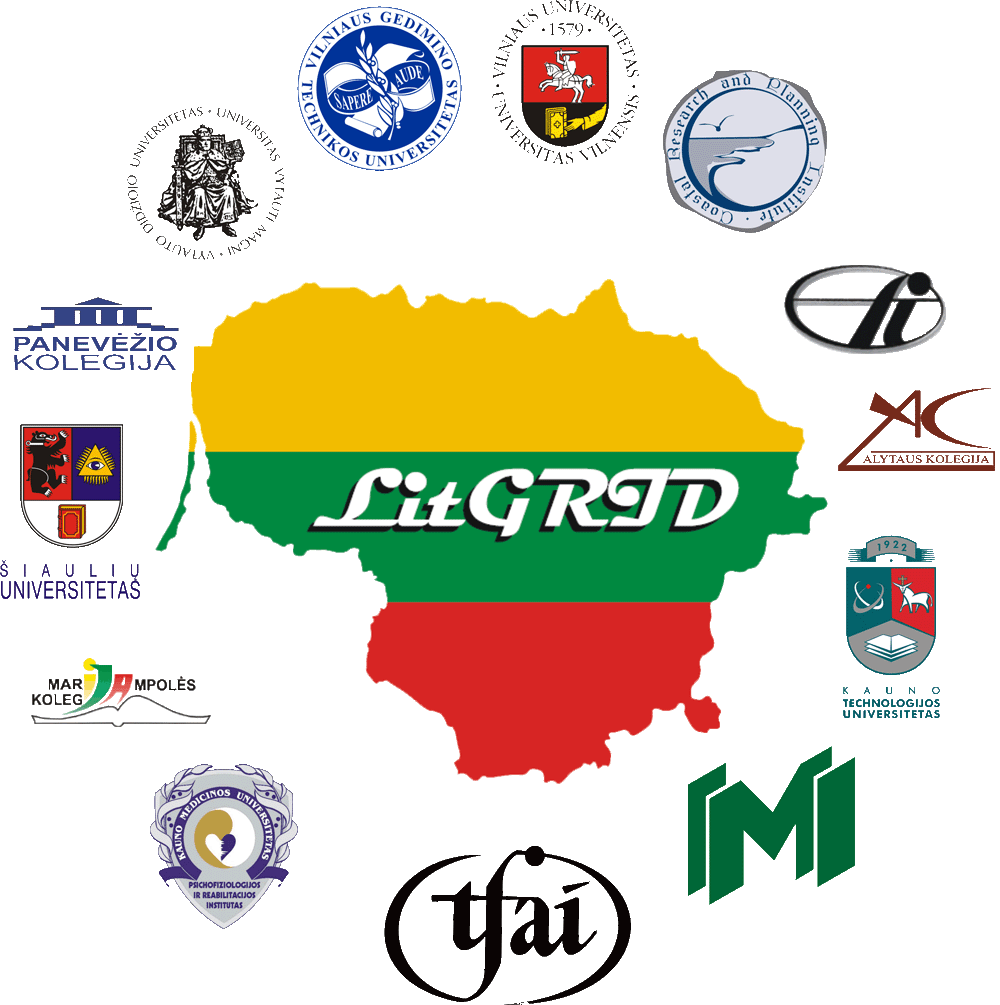
GridTechno
Grid technology has changed the approach and understanding of application and usage of computers and computing technologies. Moreover grid technologies make it possible to create a unigue type of e-services, which are utterly inefficient or impossible in other types of environment. However it is necessary to carry out suitable research in order to find out a convenient interface for applied computing, for e-services, for results presentation.
In this project, grid visualization e-Service VizLitG is developed. VizLitG is designed for convenient access and interactive visualization of remote data files located in grid.
In this project, grid visualization e-Service VizLitG is developed. VizLitG is designed for convenient access and interactive visualization of remote data files located in grid.
VizLitG
Open source grid visualization e-Service VizLitG is designed for convenient access and interactive visualization of remote data files located in grid. VizLitG is employed for visualization of scientific results computed on Lithuanian grid (LitGrid). VizLitG is build by Java and GlassFish. The message authentication over SSL mechanism is employed for security reasons. VizLitG includes automatic HDF5 data management and VTK visualization engine. Moreover, transfer of interactively selected parts of datasets located in experimental Storage Element has been implemented.
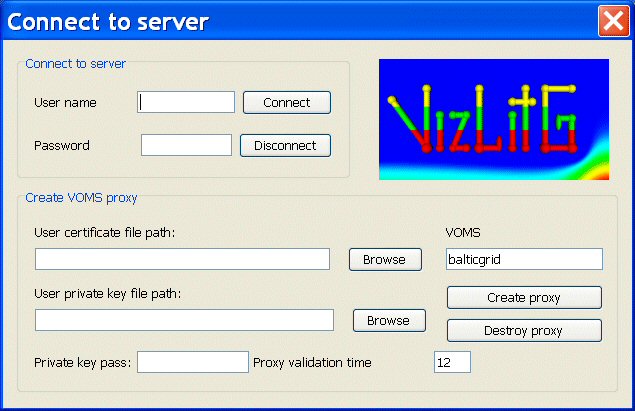
Main features of VizLitG
- Remote instrumentation provided by Java EE and GlassFish.
- HDF5 data management and interactive data selection based on GUI.
- Interactive construction of visualization network (described by XML).
- Visualization engine is based on VTK toolkit.
- Visualizations can be grouped in several viewports.
- Full interactivity including VTK widgets is provided by GVid.
- Full file transfer from SE by means of LFC (LCG) and GridFTP.
- Visualization of interactively selected parts of datasets transferred from experimental SE by using JAX-WS.
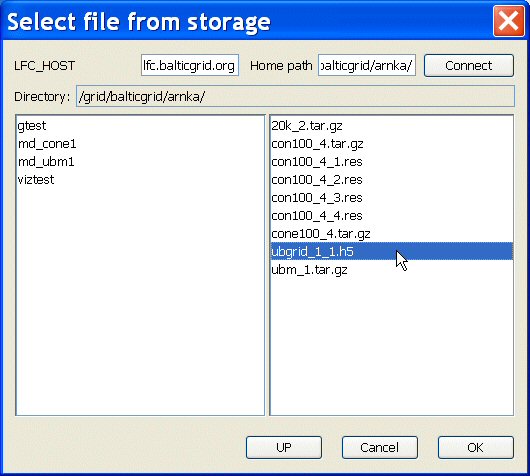
Architecture of the e-service
The client-server architecture of VizLitG is based on widely recognized web standards. The e-service is implemented in GlassFish application server. The visualization server runs on special User Interface for Graphics (UIG). Thus, natural access to grid resources is available. The light-weighted client is implemented as Java application. Data files located in SE can be accessed by using traditional means like LFC (LCG). The additional application server runs on the experimental SE in order to provide special data services able processing and transferring the selected parts of datasets.
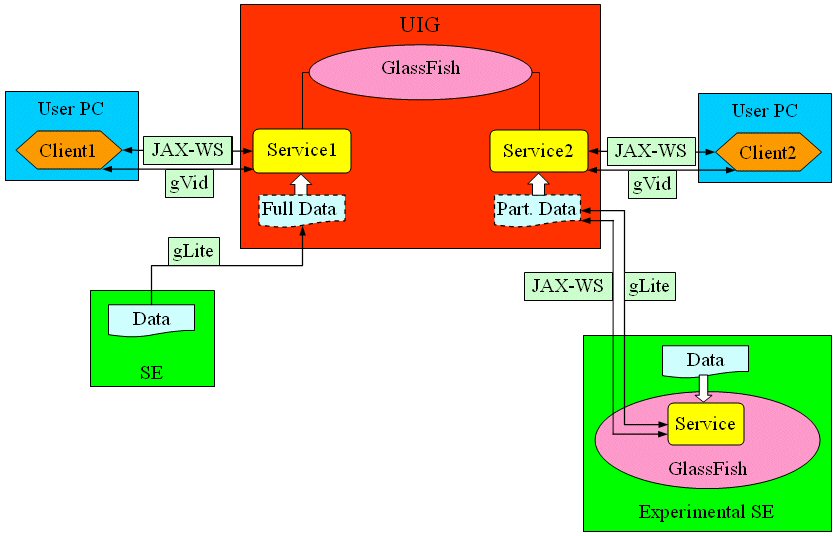
Interactivity
In order to provide for remote users high interactivity level, GVid software was implemented in VizLitG as video-streaming module. The most importand GVid classes were renewed to support VTK 5.4. The compressed video stream is efficiently transferred through the network and displayed on the client by the Viewer. VTK interactor styles are available for users as well as VTK widgets. Thus, remote user has full interactivity provided by VTK based application.
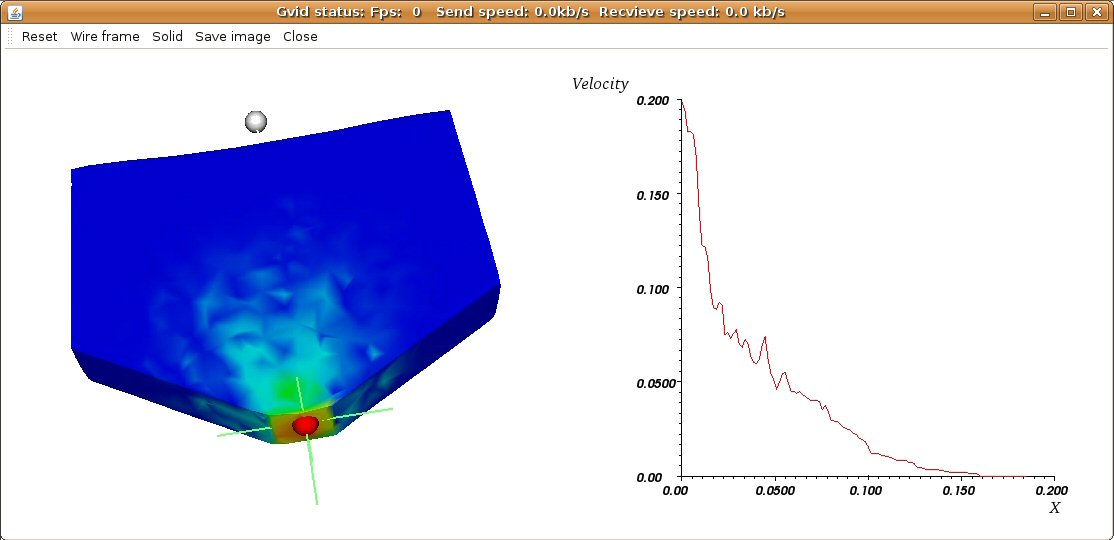
HDF5 data management
GUI allows automatic data management and interactive dataset selection. In order to process HDF5 files automatically, datasets are stored in predefined structure allowing the software to interpret the structure and contents of a file without any outside information. HDF5 groups and datasets are automatically processed considering values of HDF5 attributes. Time dependent and time independent data are processed differently. Datasets that do not change in time are located in the group Common. Datasets varying in time are grouped and stored according to time step number. GUI separates geometry and topology from attributes like scalars or vectors in order to emphasize their different nature.
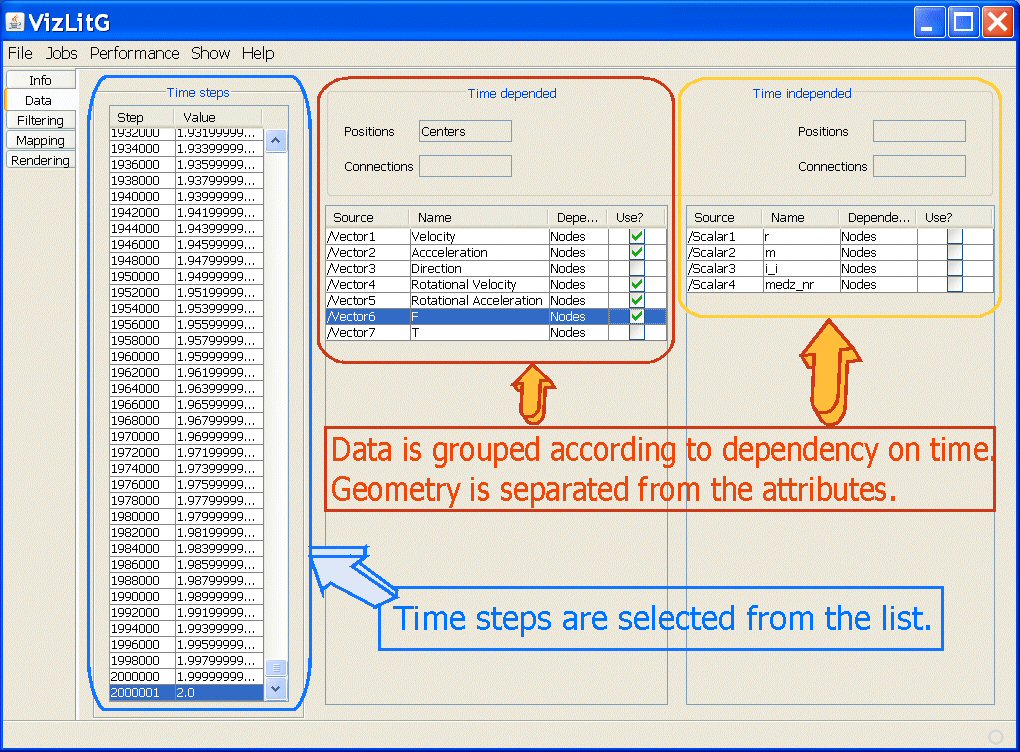
Visualization network
The visualization engine of the VizLitG is based on VTK toolkit. VTK objects are enwrapped by Java programming language in order to build the service. A visualization network is assembled from VTK objects by using GUI. The resulting pipelines are described by XML language. Valid XML documents are automatically generated on a client and transferred to the server by JAX-WS.
Tabular design of GUI fields simply illustrates the dataflow. In the filtering window, the attention is focused on the dataset changes in order to provide information for users about ongoing work of filters involved. The window consists of three areas: a visualization network constructed from several branches, parameters of the selected filter and current dataset of the selected pipeline.
In the upper part of the window, each pipeline is shown in the separate line. The parameters of the selected filter are entered in corresponding fields of the middle part of the filtering window. The lower part of the filtering window is designed for displaying the current data of the selected pipeline. Different data is colored by different colors. User can see sources, actual names and types of the attributes. The last column shows how attributes are used.
The mapping window consists of three areas. The upper area shows a visualization network. User selects pipeline in order to see data information, which is displayed in the middle part of the window. Each line in the provided table shows attribute, which can be mapped to the geometric representation in the desired form. User selects desired attribute, chooses available mapper from the combo box and presses the button Add. The necessary parameters of the selected mapper are shown in corresponding fields of the lower part of the mapping window.
Tabular design of GUI fields simply illustrates the dataflow. In the filtering window, the attention is focused on the dataset changes in order to provide information for users about ongoing work of filters involved. The window consists of three areas: a visualization network constructed from several branches, parameters of the selected filter and current dataset of the selected pipeline.
In the upper part of the window, each pipeline is shown in the separate line. The parameters of the selected filter are entered in corresponding fields of the middle part of the filtering window. The lower part of the filtering window is designed for displaying the current data of the selected pipeline. Different data is colored by different colors. User can see sources, actual names and types of the attributes. The last column shows how attributes are used.
The mapping window consists of three areas. The upper area shows a visualization network. User selects pipeline in order to see data information, which is displayed in the middle part of the window. Each line in the provided table shows attribute, which can be mapped to the geometric representation in the desired form. User selects desired attribute, chooses available mapper from the combo box and presses the button Add. The necessary parameters of the selected mapper are shown in corresponding fields of the lower part of the mapping window.
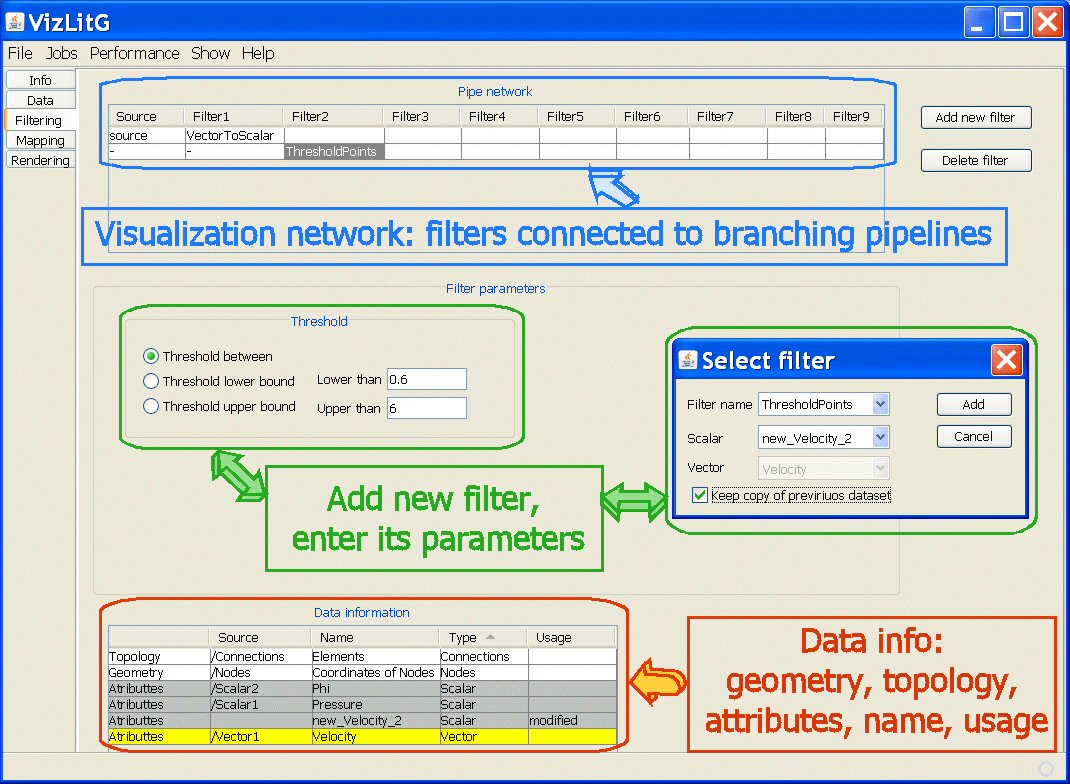
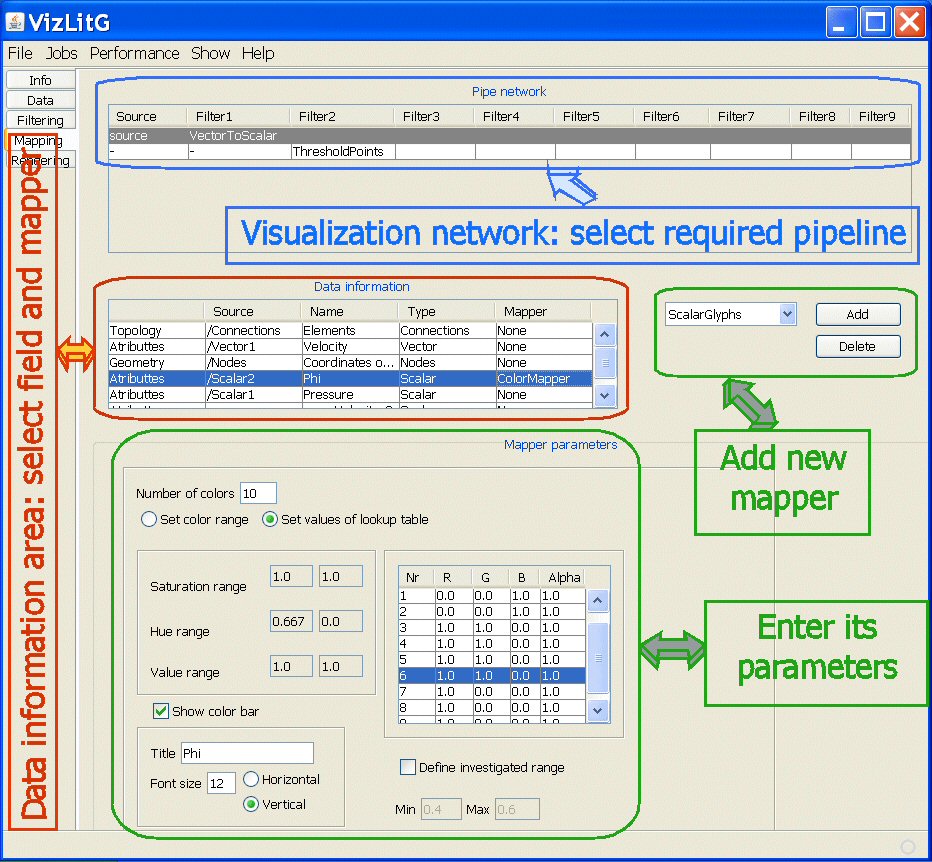
Multiple viewports
Multiple VTK renderers can work in one render window, therefore, complex visualizations can be grouped in several viewports (up to 4). The figure illustrates rendering window. User specifies the Size of main window. Each renderer renders to its own viewport. If user desires to see created visual representations in separate viewports, he can Set number of view ports. Each line of created visual representation (scalar field, vector field, geometry or topology) should be bound to windows number. Very important GVID settings are defined in the lower part of rendering window. Client IP address defines location of the client PC. Port number is very important for socket connection.
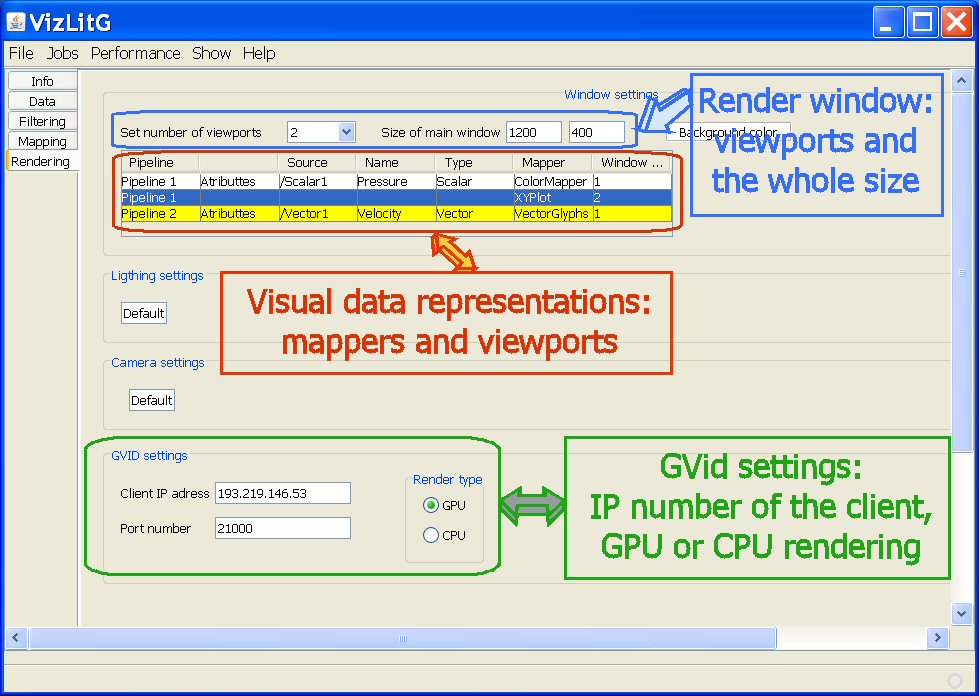
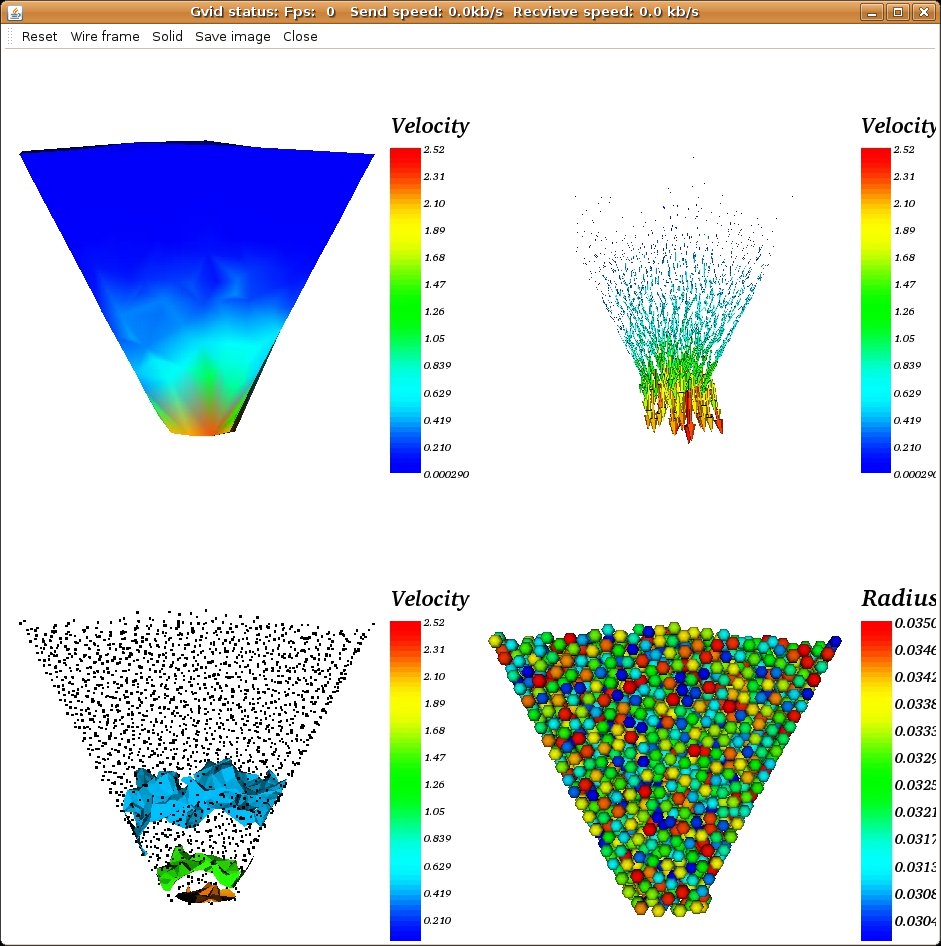
Installation guide:
Users manual:
Demonstration on VizLitG usage included in the interactive demo “Visualization e-services and tools for grid build by gLite” presented in EGEE’09, Barcelona:
VizLitG_1280_720.mp4
A technical brochure on grid visualization e-service VizLitG:
VizLitG-Brochure.pdf
A poster "Grid Visualization e-Service VizLitG":
Poster_VizLitG_Red.pdf
VizLitG_1280_720.mp4
A technical brochure on grid visualization e-service VizLitG:
VizLitG-Brochure.pdf
A poster "Grid Visualization e-Service VizLitG":
Poster_VizLitG_Red.pdf
Functionallity:
Implemented filters:
- Extracts the defined part of geometry (vtkExtractGeometry),
- Removes some points considering scalar field values (vtkThresholdPoints),
- Process vector fields (vtkArrayCalculator),
- Creates connections (vtkDelaunay3D, vtkDelaunay2D),
- Cuts and clips geometry (vtkCutter, vtkClipDataSet, vtkProbeFilter).
Implemented mappers:
- Visualization of positions (vtkGlyph3D, vtkGlyph2D, vtkIdFilter, vtkLabeledDataMapper).
- Visualization of connections (vtkExtractEdges, vtkTubeFilter),
- Visualization of outlines (vtkOutlineFilter),
- Visualization of scalars by using Glyphs (vtkGlyph3D, vtkGlyph2D),
- Visualization of vectors by using Glyphs (vtkGlyph3D, vtkGlyph2D),
- Visualization of scalars by using color mapping (vtkScalarsToColors, vtkLookupTable),
- Visualization of scalars by using iso-surfaces (vtkContourGrid),
- Visualization by using 2D plots (vtkXYPlot),
- Visualization of streamlines (vtkStreamTracer, vtkTubes, vtkGlyph3D, vtkGlyph2D).
Applications:
Velocity vectors
Dam break: moving interface, velocity vectors and plot of bottom pressure
Vilnius University
Vilnius Gediminas Technical University
Kaunas University of Technology
Klaipėda University
Vilnius University, Institute of Theoretical Physics and Astronomy
Vilnius Gediminas Technical University
Kaunas University of Technology
Klaipėda University
Vilnius University, Institute of Theoretical Physics and Astronomy
In this project, grid visualization e-Service VizLitG is developed. VizLitG is designed for convenient access and interactive visualization of remote data files located in grid.
BalticGrid-II
Grid computing is one of the way of distributed computing when tasks are shared over multiple computers. Tasks can range from data storage to complex calculations and can be spread over large geographical distances. Distributed computing resources are joined together to create a virtual supercomputer. Networked computers can work on the same problems, traditionally reserved for supercomputers. The idea of grid computing originated with Ian Foster, Carl Kesselman and Steve Tuecke in the middle of 1990s.
Laboratory of Parallel Computing of Vilnius Gediminas Technical University has started their activity in grid computing at 2004 when first testbed grid based on ARC middleware was installed together with colleagues from Vilnius University and Kaunas University of Technology. Shortly after that gLite cluster was built and connected to Litgrid and BalticGrid infrastructure. Lab activity focuses on developing visualization tools for grid computing, gridification of different applications and user support. Lab participates in several grid related projects: FP7 project BalticGrid-II (2008-2010), Litgrid (2006-2009) and GridTechno (2007-2009) projects.
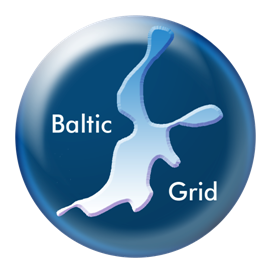
Balticgrid II project overview
The BalticGrid Second Phase (BalticGrid-II) project has started on 1 May 2008. It is designed to increase the impact, adoption and reach, and to further improve the support of services and users of the recently created e-Infrastructure in the Baltic States.
The consortium is composed of 13 leading institutions in seven Europeanian countries, with 7 institutions in Estonia, Latvia and Lithuania, 2 in Belarus, 2 in Poland, and one each in Sweden and Switzerland.
The e-Infrastructure, based on the successful BalticGrid project, is fully interoperable with the pan-European e-Infrastructures established by EGEE, EGEE associated projects, and the EGI, with the goal of a sustained e-Infrastructure in the Baltic Region.
The e-Infrastructure of 26 clusters built in five countries during the first phase of the BalticGrid is envisaged to grow, both in capacity and capability of its computing resources
BalticGrid-II identifying and addressing the specific needs of new scientific communities such as nano-science and engineering sciences; and by establishing new Grid services for linguistic research, Baltic Sea environmental research, data mining tools for communication modelling and bioinformatics. The overall vision is to support and stimulate scientists and services used in the Baltic region to conveniently access critical networked resources both within Europe and beyond, and thereby enable the formation of effective research collaborations.
More information can be found in BalticGrid II web site.
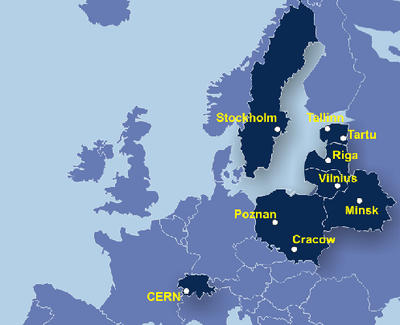
|
|
Partner name
|
Short name
|
Country
|
|---|---|---|---|
| 1 | Kungliga Tekniska Högskolan | KTH | Sweden |
| 2 | Estonian Educational and Research Network | EENET | Estonia |
| 3 | Keemilise ja Bioloogilse Füüsika Instituut | KBFI | Estonia |
| 4 | Institute of Mathematics and Computer Science, University of Latvia | IMCS | Latvia |
| 5 | Instytut Fizyki Jadrowej, im. Henryka Niewodniczanskiego, Polskiej Akademii Nauk, Kraków | IFJ PAN | Poland |
| 6 | Instytut Chemii Bioorganicznej | PAN PSNC | Poland |
| 7 | Vilnius University | VU | Lithuania |
| 8 | Riga Technical University | RTU | Latvia |
| 9 | Vilnius University Institute of Theoretical Physics and Astronomy | ITPA | Lithuania |
| 10 | European Organization for Nuclear Research | CERN | Switzerland |
| 11 | Research Division of Belarusian National Technical University | NICH BNTU | Belarus |
| 12 | United Institute of Informatics Problems of National Academy of Sciences of Belarus | UIIP NASB | Belarus |
| 13 | Vilnius Gediminas Technical University | VGTU | Lithuania |
The BalticGrid II project consists of four Networking Activities (NA), three specific Services Activities (SA) and two Joint Research Activities (JRA). Detail activity list is given bellow.
| Activity Number | Descriptive Title |
|---|---|
| Networking Activities | |
| NA1 |
Management of the Project |
| NA2 |
Education, Training, Dissemination and Outreach |
| NA3 |
Application Identification and Collaboration |
| NA4 |
Policy and Standards Development |
| Specific Service Activities | |
| SA1 |
Grid Operation |
| SA2 |
Network Resource Provisioning |
| SA3 | Application Integration and Support |
| Research Activities | |
| JRA1 |
Enhanced Application Services on Sustainable e-Infrastructure |
Vilnius Gediminas Technical University participates in following activities: NA2, NA3, SA1, SA3, JRA1.
Short description of VGTU activities
NA2
VGTU actively participate in NA2 activity. During the project the following results was achieved:
- 5 paper were published in different Lithuanian newspapers and journals about BalticGrid II project
- 3 posters and demo about visualization tools VizLitG and Paraview were presented at EGEE'09 User Forum in Barcelona
- 3 technical brochures about gridified engineering applications and visualization tools have been prepared
- 7 presentation about Balticgrid and BalticCloud were given at different conferences, seminars and meeting
- Balticgrid II project Kick-off meeting with Grid Open Day has been organized in Vilnius (May 2008)
NA3
VGTU participate in Engineering Modeling Task of NA3 together with partners from RTU and BNTU. Four applications have been deployed on Balticgrid II infrasructure during the project - Grill, FEMTOOL, DEMMAT, Vibroengineering. More detail information about applications are given in Applications section.
SA1
VGTU is one of the partners that has installed central BalticGrid services: BDII, WMS, VOMS, MON. Two gLite clusters (total 60 CPU) are included into BalticGrid infrastructure. Also CREAM cluster is installed and available for testing. All clusters have EGEE production status. One of the VGTU cluster administrator is BalticGrid CA local RA.
SA3
VGTU user support team is part of BalticGrid SA3 team. They are responsible for Balticgrid user support from Lithuania but also is working with international SA3 task such as BalticGrid users accouting system, gEclipse compatibility problem, gLite - UNICORE compatibility issues.
JRA1
The JRA1 activity consolidates new generation middleware technologies and eInfrastructure services within user-friendly graphical environment, which extends an intuitive user interface to Grid (Migrating Desktop Platform and Gridcom). VGTU activity focuses on visualisation of computing results and integration it with Migrating Desktop Platform. Software developed during BalticGrid project can be found in software section.
Following applications from Engineering Modeling Task is developed and deployed in BalticGrid infrastructure.
- Foundation Engineering (GRILL) is global optimazation problem of grillage-type foundations using genetic algorithms
- Particle Technology (DEMMAT)is software used for particle flows, nano-powders, material structure modelling on microscopic level using Discrete Element Method
- Computational Fluid Dynamics (FEMTOOL) Modelling of viscous incompressible free surface flows
- Vibroengineering Modeling (VIBRO) and numerical simulation of piezoelectric actuators, tranducers and motors using ANSYS software
Description
The optimal design of grillage-type foundations is a specific class of optimization problems in civil engineering. The grillages which consist of piles and connecting beams, are the most popular and effective scheme of foundations, especially in case of weak grounds. The optimal grillage is the one that meets twofold criteria: it is supported with minimal quantity of piles, and its connecting beams receive minimum possible torques. The problem is solved by the global optimization methods: random search and its modifications, simulated annealing and genetic algorithms. Performed numerical experiments are fully independent of each other. No communication between processes is necessary. Thus, such optimization problems are ideally suited for grid computing.
Technical information
Grill software is academic, open source, developed at Vilnius Gediminas Technical University. Required CPU number depends on problem size. Estimated number of CPU hours for our current problem solving is 50 0000.
Description
The development of the appropriate theoretical framework as well as numerical research tools for prediction of constitutive behaviour with respect to microstructure belongs to major problems of computational sciences. In general, the macroscopic material behaviour is predefined by the structure of grains of various size and shape, or even by individual molecules or atoms. Motion and inter-action of them has to be taken into account to achieve a high degree of accuracy. The discrete element method (DEM) is an attractive candidate to be applied for modelling of granular flows, nano-powders and other materials on microscopic level. It belongs to the family of numerical methods and refers to conceptual framework on the basis of which appropriate models, algorithms and computational technologies are derived. The main disadvantages of the DEM technique, in comparison with the well-known continuum methods, are related to computational capabilities which are limited by a huge number of particles and a short time interval of simulations. The small time step imposed in the explicit time integration schemes gives rise to the requirement that a very large number of time increments should be performed. Naturally, for the solution of industrial-scale problems, distributed computing and GRID technologies becomes an obvious option for significantly increasing computational capabilities. The increased role of inter-disciplinary co-operation and development of new technologies may be also qualified to major factors driving the progress of the DEM models and countless applications. A lot of challenging scientific and industrial problems has been solving by developed DEMMAT_PAR code. The most interesting examples include actual problems such as nano-powders, compacting, mixing, hopper discharge and crack propagation in building constructions.
Technical information
DEMMAT is parallel type and open source software developed at Vilnius Gediminas Technical University. Code is written using Fortran 90, OpenMP library is included. Minimal requirement for the processor is Intel Pentium 3.2 Mhz, 1GB RAM. Recommended amount of disk space for data is till 100 GB. Software is communication intensive, so minimal bandwidth between WN must be 1 Gbps. Large scale models require great computational power (hundreds CPU).
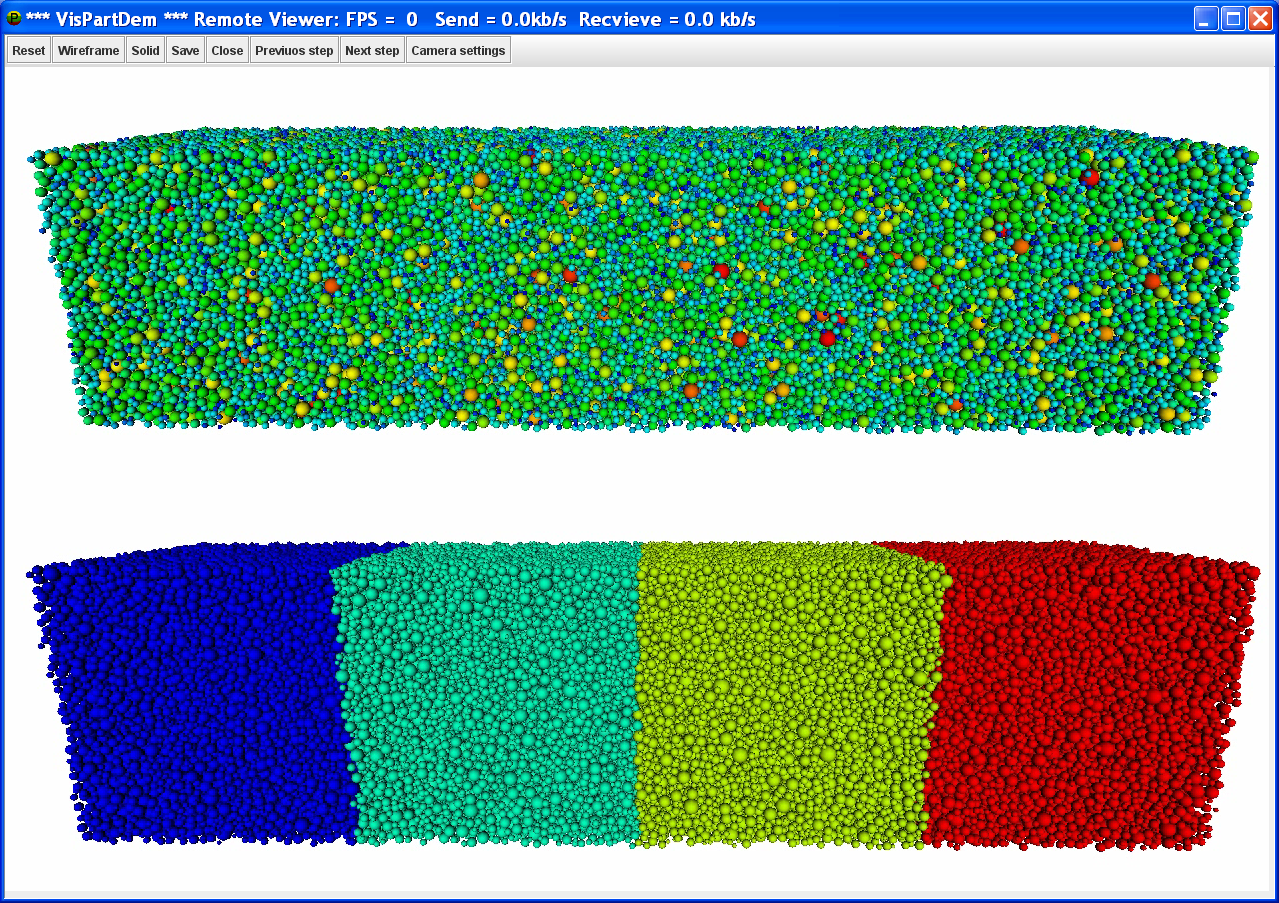
Description
The computational fluid dynamics (CFD) provide general methods for solving wide range of actual applications in the wide areas of engineering. Many important industrial problems include convective transport, viscous incompressible flows governed by the Navier-Stokes equations, moving interfaces and coupled problems. Sluice gates, dam break flows, tank sloshing, sediment and pollution transport has been modelled by the developed software FEMTOOL. The main part of the software is parallel iterative algorithms for solving large systems of linear equations obtained modelling various problems of Computational Fluid Dynamics. The parallelization of the code is based on the domain decomposition. The mesh partitioning is performed by METIS. The systems of linear equations are solved by the iterative Generalised Minimal Residual solver (GMRES).
Technical information
FEMTOOL source code is academical and open source. Code is written using Fortran 77, MPI and ATLAS libraries are included. Minimal requirement for the processor is Intel Pentium 3.2 Mhz, 1GB RAM. Recommended amount of disk space for data is 1GB. Software is communication intensive, so minimal bandwidth between WN must be 1 Gbps. FEMTOOL is integrated with Migrating Desktop. Grid visualization e-service VizLitG is used for visualization of computed results.
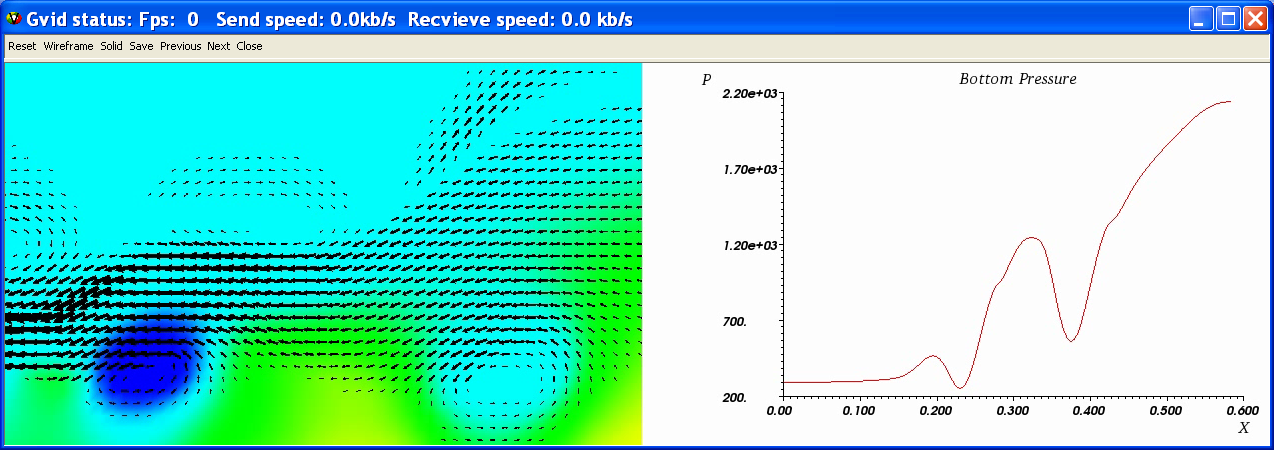
Description
Vibroengineering is one of the branches of mechatronics that analyses mechanical systems under high frequency vibrations. Active and passive control systems with/without feedback are used to control vibrations of the mechanical systems. Development and analysis of piezoelectric actuators, tranducers and motors are one of the branch of vibroengineering. The aims of the application are to investigate contact – impact phenomena in the piezoelectric motors, to optimize design of the piezoelectric actuators and motor and achieve optimal control using feedback systems.
Technical information
Well known finite element modeling software ANSYS is used for vibroengineering problems modeling. Large scale dynamic and optimization problem is solved during simulation of the actuators and motors. Distributed computing is prefered in order to reduce computing time. Requered CPU number depends on the problem size.
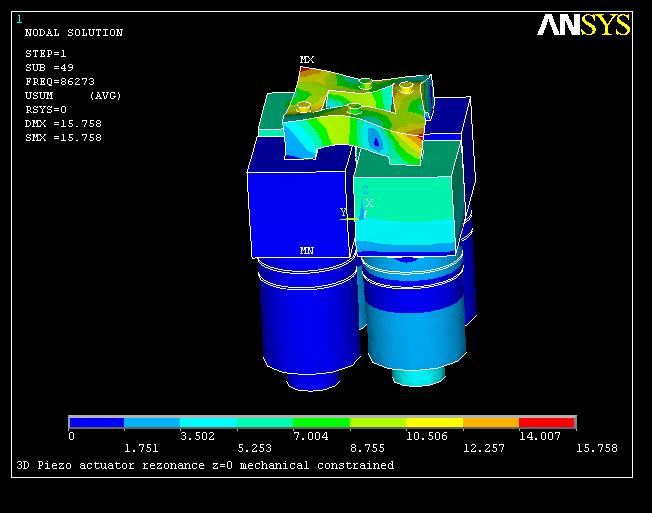
Model of 3DOF piezoelectric actuator
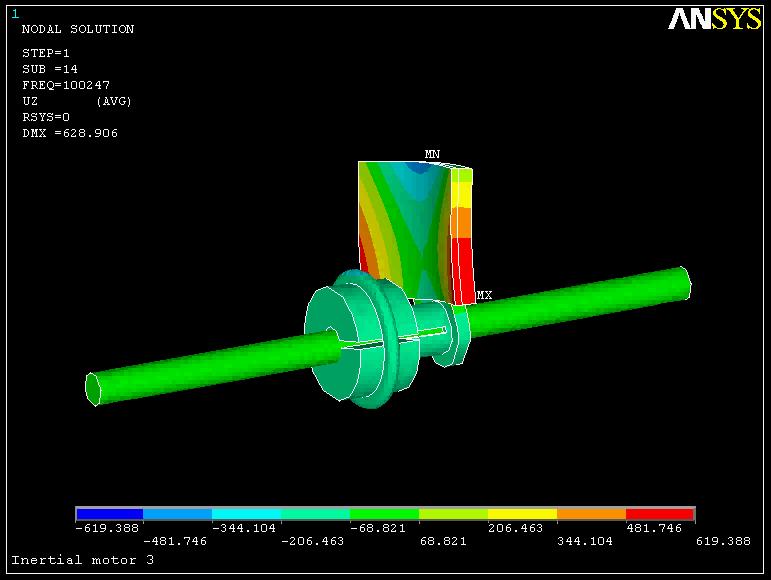
Model of linear inertial type piezoelectric motor
Considering the analysis performed in Joint Research Activity (JRA) and reported in DJRA1.1, three different visualization tools have been deployed on BalticGrid-II testbed for visualization in order to provide for grid users enchanced application services:
|
|
|
|---|---|
| VizLitG | - the service for convenient access and visualization of remote data files located in the grid |
| VisPartDem | - distributed visualization tool for particle systems |
| ParaView | - an open-source software for parallel visualization and parallel rendering of large datasets |
VGTU leader
dr. Dalius Mažeika
Department of Information Systems
Vilnius Gediminas Technical University
Saulėtekio al. 11, Vilnius LT-10223
Lithuania
phone: +370 5 2744830
e-mail:crypt:PGEgaHJlZj0ibWFpbHRvOmRhbGl1cy5tYXplaWthQHZndHUubHQiPmRhbGl1cy5tYXplaWthQHZndHUubHQ8L2E+:xx
dr. Dalius Mažeika
Department of Information Systems
Vilnius Gediminas Technical University
Saulėtekio al. 11, Vilnius LT-10223
Lithuania
phone: +370 5 2744830
e-mail:crypt:PGEgaHJlZj0ibWFpbHRvOmRhbGl1cy5tYXplaWthQHZndHUubHQiPmRhbGl1cy5tYXplaWthQHZndHUubHQ8L2E+:xx
VGTU applications leader
dr. Arnas Kačeniauskas
Laboratory of Parallel Computing
Vilnius Gediminas Technical University
Saulėtekio al. 11, Vilnius LT-10223
Lithuania
phone: +370 5 2744913
e-mail:crypt:PGEgaHJlZj0ibWFpbHRvOmFybmthQHZndHUubHQiPmFybmFzLmthY2VuaWF1c2thc0B2Z3R1Lmx0PC9hPg==:xx
dr. Arnas Kačeniauskas
Laboratory of Parallel Computing
Vilnius Gediminas Technical University
Saulėtekio al. 11, Vilnius LT-10223
Lithuania
phone: +370 5 2744913
e-mail:crypt:PGEgaHJlZj0ibWFpbHRvOmFybmthQHZndHUubHQiPmFybmFzLmthY2VuaWF1c2thc0B2Z3R1Lmx0PC9hPg==:xx
Detail list of BalticGrid contact persons can be found here.
FEMTOOL
FEMTOOL is a general and flexible finite element toolbox allowing to solve any type of coupled partial differential equations. Space-time finite elements and the high order shape functions generated automatically make FEMTOOL to be applicable to various CFD problems of interest. Sluice gates, dam break flows, tank sloshing, sediment and pollution transport has been modelled by FEMTOOL. CFD software FEMTOOL was developed in Eidgenössische Technische Hochschule Zürich (ETH Zürich) and Laboratory of Parallel Computing of Vilnius Gediminas Technical University.
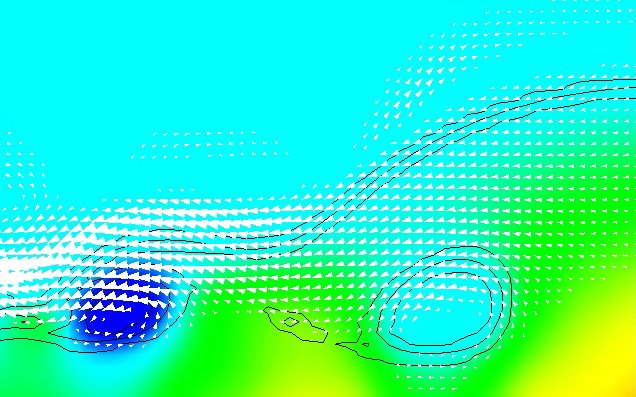
Application areas
The finite element software FEMTOOL is designed to solve coupled CFD problems described by:
- Puasson’s equation,
- Convective transport equation,
- Navier-Stokes equations,
- Shallow water equations,
- Free surfaces and moving interfaces.
Main features of the software
- Domain decomposition and load balancing are performed by METIS,
- Inter-processor communication is performed by MPI library,
- ATLAS library is employed for linear algebra,
- Parallel preconditioned GMRES solver,
- HDF5 standard for result storage,
- Visualization of results by e-service VizLitG.
Software deployment in grid
FEMTOOL version 3.0 has been deployed in BalticGrid-II. Deployment has been performed by using BalticGrid-II SGM (Software Grid Manager) system. Sites able to run FEMTOOL are marked by tag VO-balticgrid-A-ENG-FEMTOOL-3.0. Required environment can be read from the source file env.sh residing in the predefined directory. Finally, FEMTOOL code has been integrated with Migrating Desktop for convenient interactive work on grid. The special plug-in presented in the figure was programmed and implemented.
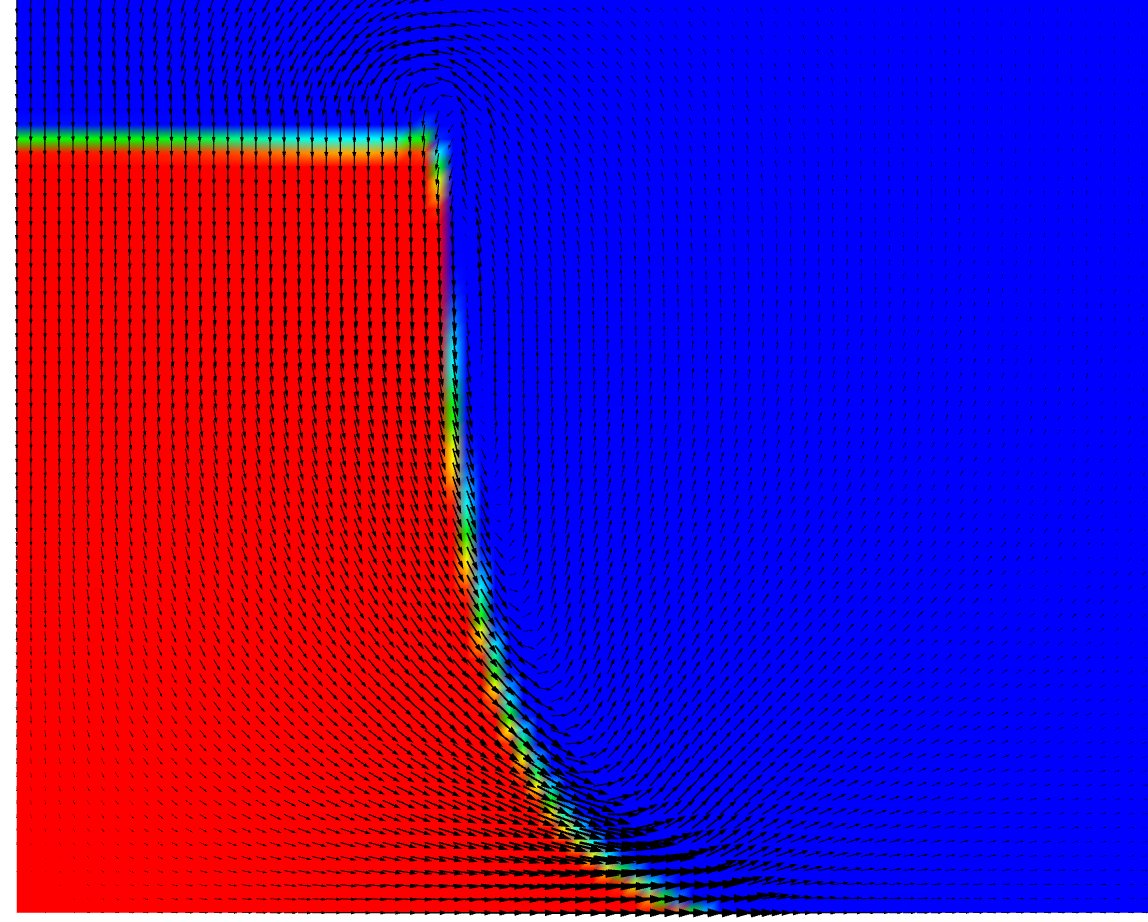
Dam break: velocity vectors and color map of pseudo-concentration function
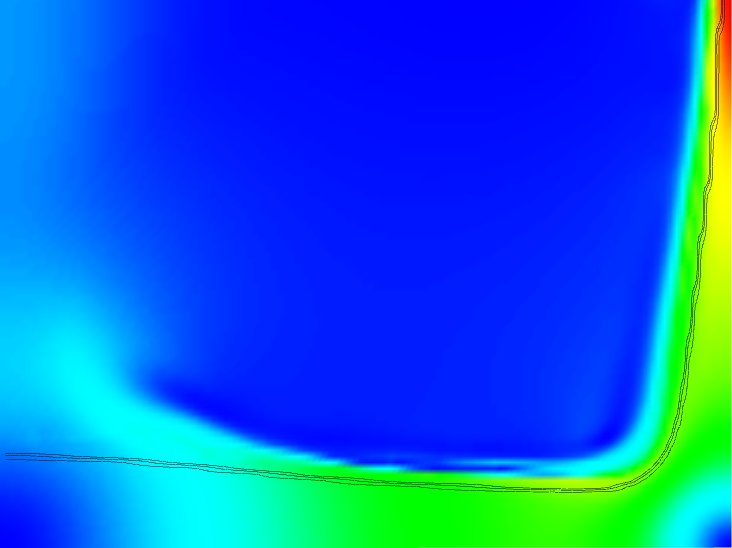
Dam break: velocity magnitude and interface contours
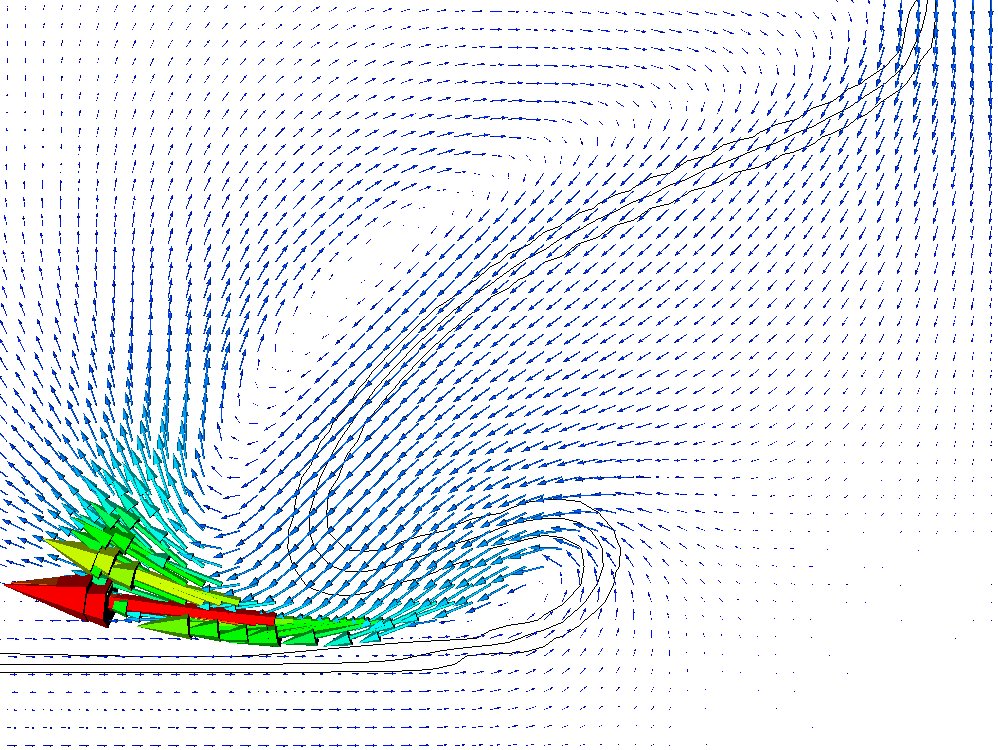
Dam break: velocity vectors and moving interface

Dam break: velocity vectors, pressure field, interface contours and plot of bottom pressure
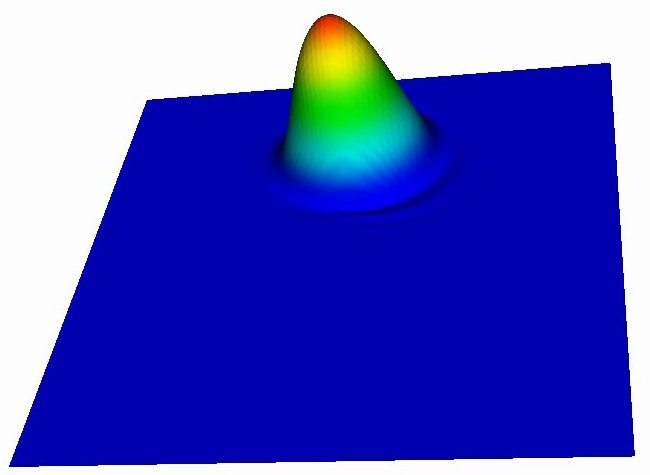
Rotating cone: elevated concentration field
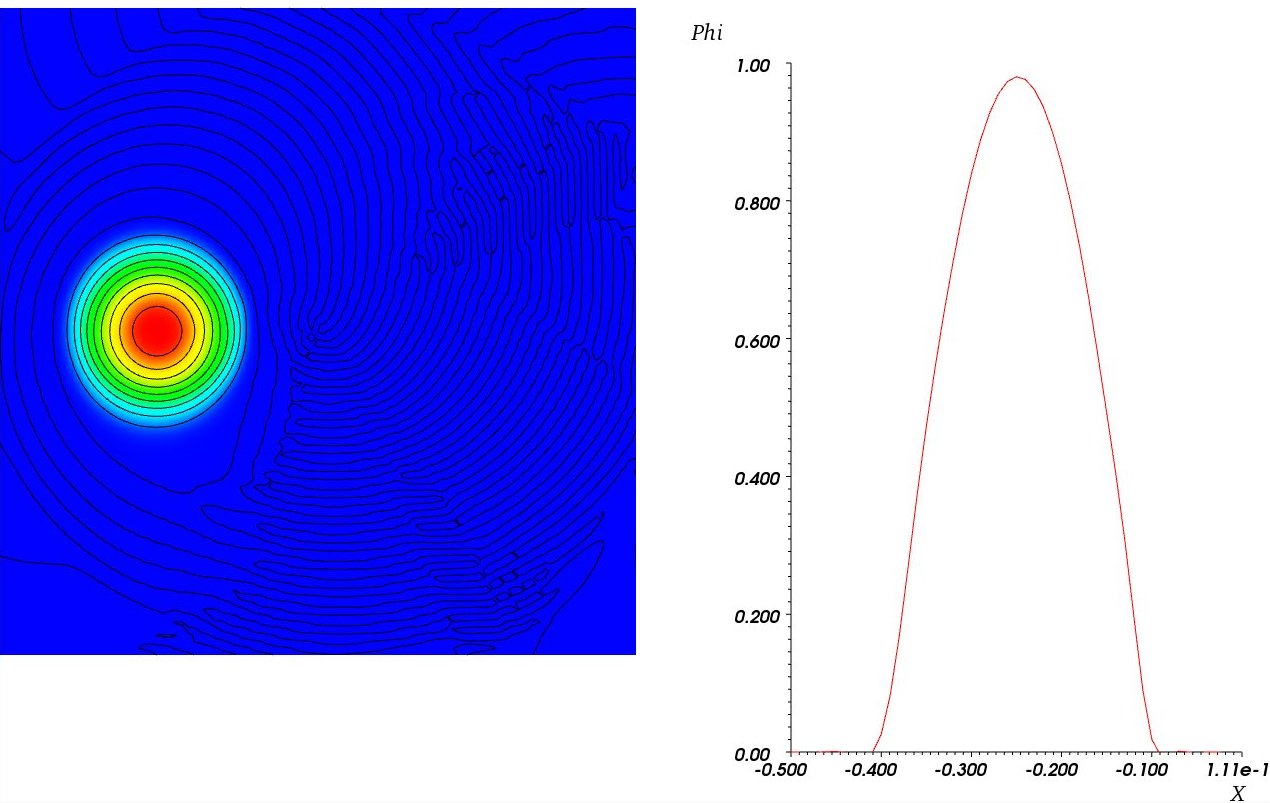
Rotating cone: concentration field, zero contour and cross-section plot
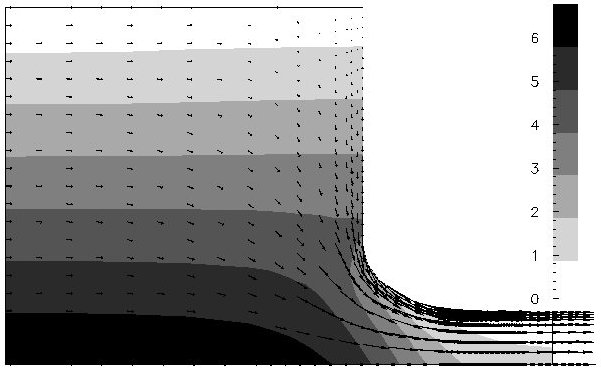
Sluice gate: velocity vectors and pressure field
VizLitG
Open source grid visualization e-service VizLitG is designed for convenient access and interactive visualization of remote data files located in grid. VizLitG is employed for visualization of scientific results computed on Lithuanian grid (LitGrid). VizLitG is build by Java and GlassFish. The message authentication over SSL mechanism is employed for security reasons. VizLitG includes automatic HDF5 data management and VTK visualization engine. Moreover, transfer of interactively selected parts of datasets located in experimental Storage Element has been implemented.

VisPartDEM
VisPartDEM is open source distributed visualization tool for large particle systems simulated by the Discrete Element Method. VisPartDEM performs intensive post-processing necessary for visualization of derived variables. Advanced algorithms based on surface extraction and Voronoi diagrams are implemented in order to obtain geometric representation of propagating cracks. VisPartDEM is designed as grid visualization tool, but it is ported on the other infrastructures.
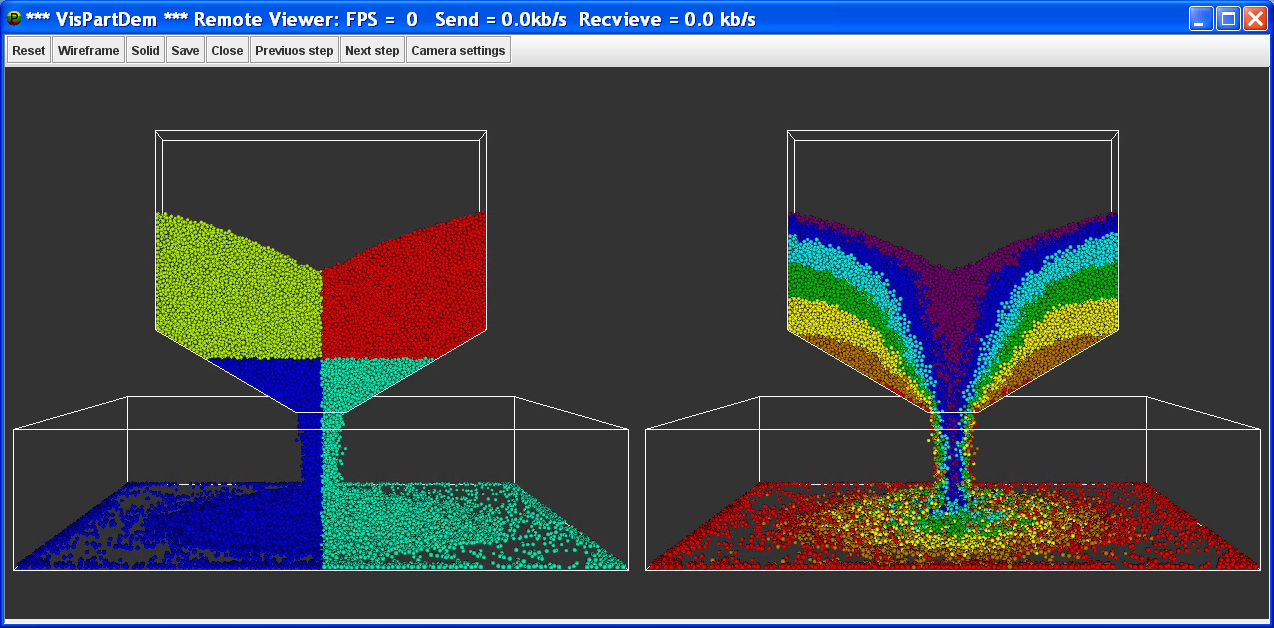
Laboratory of Parallel Computing:
Saulėtekio al. 11, 10223 Vilnius
crypt:PGEgaHJlZj0ibWFpbHRvOmxzbEB2aWxuaXVzdGVjaC5sdCIgdGl0bGU9ImxzbEB2aWxuaXVzdGVjaC5sdCI+bHNsQHZpbG5pdXN0ZWNoLmx0PC9hPg==:xx
S6(SRL-I) 320
+370 5 274 4828
9828
crypt:PGEgaHJlZj0ibWFpbHRvOnJhaW1vbmRhcy5jaWVnaXNAdmlsbml1c3RlY2gubHQiIHRpdGxlPSJyYWltb25kYXMuY2llZ2lzQHZpbG5pdXN0ZWNoLmx0Ij5yYWltb25kYXMuY2llZ2lzQHZpbG5pdXN0ZWNoLmx0PC9hPg==:xx
+370 5 274 4913
9913
crypt:PGEgaHJlZj0ibWFpbHRvOmFybmFzLmthY2VuaWF1c2thc0B2aWxuaXVzdGVjaC5sdCIgdGl0bGU9ImFybmFzLmthY2VuaWF1c2thc0B2aWxuaXVzdGVjaC5sdCI+YXJuYXMua2FjZW5pYXVza2FzQHZpbG5pdXN0ZWNoLmx0PC9hPg==:xx
+370 5 274 4854
9854
crypt:PGEgaHJlZj0ibWFpbHRvOnNlcmdlanVzLmJvcm9kaW5hc0B2aWxuaXVzdGVjaC5sdCIgdGl0bGU9InNlcmdlanVzLmJvcm9kaW5hc0B2aWxuaXVzdGVjaC5sdCI+c2VyZ2VqdXMuYm9yb2RpbmFzQHZpbG5pdXN0ZWNoLmx0PC9hPg==:xx
+370 5 274 4828
9828
crypt:PGEgaHJlZj0ibWFpbHRvOnJhaW1vbmRhcy5jaWVnaXNAdmlsbml1c3RlY2gubHQiIHRpdGxlPSJyYWltb25kYXMuY2llZ2lzQHZpbG5pdXN0ZWNoLmx0Ij5yYWltb25kYXMuY2llZ2lzQHZpbG5pdXN0ZWNoLmx0PC9hPg==:xx
+370 5 274 4913
9913
crypt:PGEgaHJlZj0ibWFpbHRvOmFybmFzLmthY2VuaWF1c2thc0B2aWxuaXVzdGVjaC5sdCIgdGl0bGU9ImFybmFzLmthY2VuaWF1c2thc0B2aWxuaXVzdGVjaC5sdCI+YXJuYXMua2FjZW5pYXVza2FzQHZpbG5pdXN0ZWNoLmx0PC9hPg==:xx
+370 5 251 2372
9372
crypt:PGEgaHJlZj0ibWFpbHRvOnV0a3Uua2FsZUB2aWxuaXVzdGVjaC5sdCIgdGl0bGU9InV0a3Uua2FsZUB2aWxuaXVzdGVjaC5sdCI+dXRrdS5rYWxlQHZpbG5pdXN0ZWNoLmx0PC9hPg==:xx
+370 5 274 4480
9480
crypt:PGEgaHJlZj0ibWFpbHRvOmFuZHJlai5idWdhamV2QHZpbG5pdXN0ZWNoLmx0IiB0aXRsZT0iYW5kcmVqLmJ1Z2FqZXZAdmlsbml1c3RlY2gubHQiPmFuZHJlai5idWdhamV2QHZpbG5pdXN0ZWNoLmx0PC9hPg==:xx
+370 5 274 4829
9829
crypt:PGEgaHJlZj0ibWFpbHRvOmRhaW5pdXMuY2Vwb25pc0B2aWxuaXVzdGVjaC5sdCIgdGl0bGU9ImRhaW5pdXMuY2Vwb25pc0B2aWxuaXVzdGVjaC5sdCI+ZGFpbml1cy5jZXBvbmlzQHZpbG5pdXN0ZWNoLmx0PC9hPg==:xx
+370 5 274 4480
9480
crypt:PGEgaHJlZj0ibWFpbHRvOnJpbWEua3JpYXV6aWVuZUB2aWxuaXVzdGVjaC5sdCIgdGl0bGU9InJpbWEua3JpYXV6aWVuZUB2aWxuaXVzdGVjaC5sdCI+cmltYS5rcmlhdXppZW5lQHZpbG5pdXN0ZWNoLmx0PC9hPg==:xx
+370 5 274 4913
9913
crypt:PGEgaHJlZj0ibWFpbHRvOnJ1c2xhbi5wYWNldmljQHZpbG5pdXN0ZWNoLmx0IiB0aXRsZT0icnVzbGFuLnBhY2V2aWNAdmlsbml1c3RlY2gubHQiPnJ1c2xhbi5wYWNldmljQHZpbG5pdXN0ZWNoLmx0PC9hPg==:xx
+370 5 251 2523
9523
crypt:PGEgaHJlZj0ibWFpbHRvOnZhZGltYXMuc3Rhcmlrb3ZpY2l1c0B2aWxuaXVzdGVjaC5sdCIgdGl0bGU9InZhZGltYXMuc3Rhcmlrb3ZpY2l1c0B2aWxuaXVzdGVjaC5sdCI+dmFkaW1hcy5zdGFyaWtvdmljaXVzQHZpbG5pdXN0ZWNoLmx0PC9hPg==:xx
Edvinas Sulžickis
Engineer
+370 5 274 4913
9913
crypt:PGEgaHJlZj0ibWFpbHRvOmVkdmluYXMuc3Vsemlja2lzQHZpbG5pdXN0ZWNoLmx0IiB0aXRsZT0iZWR2aW5hcy5zdWx6aWNraXNAdmlsbml1c3RlY2gubHQiPmVkdmluYXMuc3Vsemlja2lzQHZpbG5pdXN0ZWNoLmx0PC9hPg==:xx
-
- Page administrators:
- Emilija Blaškevič
- Ernestas Čepulionis
- Karolina Kardokaitė
- Ugnė Daraškevičiūtė


